In our previous post we broadly discussed the mindset of composable business. While “composable” can be a long term company-wide strategy for the future, companies shouldn’t overlook smaller-scale opportunities that exist at every level to introduce more flexibility, longevity, and reduce costs of technology investments.
For maximum ROI, think big, then start small
Many organizations are daunted by the concept of shifting a legacy application or monolith to a microservices architecture. This is exacerbated when an application is nearing end of life.
Don’t discount the fact that a move to a microservices architecture can be done progressively over time, unlike the replatform of a monolith which is a huge investment in both time and money that may not be realized for years until the new application is ready to deploy.
A progressive approach allows organizations to:
- Move faster and allow for adjustments as needed
- Begin realizing returns on investments faster
- Reduce risk by making smaller investments and deployments
- Ease budgeting process by funding an overhaul in stages
- Improve quality by minimizing the scope of tests
- Save money on initial investment and maintenance where services are centralized
- Benefit from longevity of a component-based system
Prioritizing the approach by aligning technical architecture with business objectives
As with any application development initiative, aligning business objectives with technology decisions is essential. Unlike replatforming a monolith, however, prioritizing and planning the order of development and deployments is crucial to the success of the initiative.
Start with clearly defining your application with a requirements and feature matrix. Then evaluate each using three lenses to see priorities begin to emerge:
- With a current state lens, evaluate each item. Is it broken? Is it costly to maintain? Is it leveraged by multiple business units or external applications?
- Then with a future state lens, evaluate each item. Could it be significantly improved? Could it be leveraged by other business units? Could it be leveraged outside the organization (partners, etc…)? Could it be leveraged in other applications, devices, or locations?
- Lastly, evaluate the emerging priority items with a cost and effort lense. What is the level of effort to develop the feature as a service? What is the likely duration of the effort?
Key considerations when planning a progressive approach
Planning is critical to any successful application development initiative, and architecting a microservices based architecture is no different. Be sure to consider the following key items as part of your planning exercises:
- Remember that rearchitecting a monolith feature as a service can open the door to new opportunities and new ways of thinking. It is helpful to ask “If this feature was a stand alone service, we could __”
- Be careful of designing services that are too big in scope. Work diligently to break down the application into the smallest possible parts, even if it is later determined that some should be grouped together
- Keep security front of mind. Where a monolith may have allowed for a straightforward security management policy with everything under one roof, a services architecture provides the opportunity for a more customized security policy, and the need to define how separate services are allowed to communicate with each other and the outside world
In summary
A microservices architecture is an approach that can help organizations move faster, be more flexible and agile, and reduce costs on development and maintenance of software applications. By taking a progressive approach when architecting a monolith application, businesses can move quickly, reduce risk, improve quality, and reduce costs.
If you’re interested in introducing composability to your organization, we’d love to help! Contact us today to talk about your options.
Many organizations today, large and small, have a digital asset problem. Companies are amassing huge libraries of images, videos, audio recordings, documents, and other files — while relying on shared folders and email to move them around the organization. As asset libraries explode, digital asset management (DAM) is crucial for keeping things accessible and up to date, so teams can spend more time getting work done and less time hunting for files.
First Things First: DAM isn’t Dropbox
Some folks still equate DAM with basic digital storage solutions, like Dropbox or Google Drive. While those are great for simple sharing needs, they’re essentially just file cabinets in the cloud.
DAM technology is purpose-built to optimize the way you store, maintain, and distribute digital assets. A DAM platform not only streamlines day-to-day content work; it also systematizes the processes and guidelines that govern content quality and use.
Today’s DAMs have sophisticated functionality that offers a host of benefits, including:
- Providing efficient access for internal and external teams
- Streamlining workflows for sharing drafts and getting approvals
- Serving images in multiple sizes and formats, reducing duplication
- Enabling AI-powered categorization, tagging, and license tracking
- Preventing versioning and legal issues around asset use
Is it time for your business to invest in a DAM? Let’s see if you recognize the pain points below:
The 5 Signs You Need a DAM
There are some things you can’t afford not to invest in if they significantly impact your team’s creativity and productivity and your business’s bottom line. Here are some of the most common signs it’s time to invest in a DAM:
It takes more than a few seconds to find what you need.
As your digital asset library grows, it’s harder to keep sifting through it all to find things — especially if you’re deciphering other people’s folder systems. If you don’t know the exact name of an asset or the folder it’s in, you’re often looking for a needle in a haystack.
Using a DAM, you can tag assets with identifying attributes (titles, keywords, etc.) and then quickly search the entire database for the ones that meet your criteria. DAMs also offer AI- and machine-learning–based tagging, which automatically adds tags based on the content of an image or document. Voila! A searchable database with less manual labor.
You have multiple versions of documents — in multiple places.
Many of our clients, including universities, healthcare systems, libraries, and nonprofits, have large collections of policy documents. These files often live on public websites, intranets, and elsewhere, with the intent that staff can pull them up as needed.
Problem is, if there’s a policy change, you need to be sure that anywhere a document is accessed, it’s the most current version. And you can’t just delete old files on a website, because any previous links to them will go up in smoke.
DAMs are excellent at managing document updates and variations, making it easy to find and replace old versions. They can also perform in-place file swaps without breaking the connections to the pieces of content that refer to a particular file.
You’re still managing assets by email.
With multiple team members or departments relying on the same pool of digital assets for a variety of use cases, some poor souls will spend hours every day answering email requests, managing edits, and transferring files. The more assets and channels you’re dealing with, the more unwieldy this gets.
DAMs facilitate collaboration by providing a single, centralized platform where team members can assign tasks, track changes, and configure permissions and approval processes. As a result, content creators know they’re using the most up-to-date, fully approved assets.
Your website doubles as a dump bin.
If your website is the source of assets for your entire organization, it can be a roadblock for other departments that need to use those assets in other places. They need to know how to find assets, download copies, and obtain sizes or formats that differ from the web-based versions… and there may or may not be a web team to assist.
What’s more, some web hosting providers offer limited storage space. If you have a large and growing digital library, you’ll hit those limits in no time.
A DAM provides a high-capacity, centralized location where staff can easily access current, approved digital assets in various sizes and formats.
You’re duplicating assets you already have.
How many times have you had different teams purchase assets like stock photography and audio tracks, when they could have shared the files instead? Or, maybe your storage folders are overrun with duplicates. Instead of relying on teams to communicate whenever they create or use an asset, you could simplify things with a DAM.
Storing and tagging all your assets, in various sizes and formats, in a DAM enables your teams to:
- Make the most of the assets you own
- Avoid creating unnecessary copies
- Access optimized versions for different applications
- Keep track of how many times each asset is used
When Should You Implement a DAM?
You can implement a DAM whether you have an existing website or you’re building a new one. DAM technology easily complements platform builds or redesigns, helping to make websites and intranets even more powerful. Organizing all of your assets in a DAM before launching a web project also makes it easier to migrate them to your new platform and helps ensure that nothing gets lost.
Plus, we’ve seen companies cling to old websites when too many departments are still using assets that are hosted on the site. Moving your assets out of your website and into a DAM frees you up to move on.
If you’re curious about your options for a DAM platform, there are a number of solutions on the market. Our partner Acquia offers an excellent DAM platform with an impressive range of functions for organizing, accessing, publishing, and repurposing assets, automating manual processes, and monitoring content metrics.
Other candidates to consider include Adobe Experience Manager Assets, Bynder, PicturePark, Canto, Cloudinary, Brandfolder, and MediaValet.
Given the number of DAMs on the market, choosing the right solution is a process. We’re happy to share our experience in DAM use and implementation, to help you find the best one for your needs. Just get in touch with any questions you have.
While the terminology was first spotlighted by IBM back in 2014, the concept of a composable business has recently gained much traction, thanks in large part to the global pandemic. Today, organizations are combining more agile business models with flexible digital architecture, to adapt to the ever-evolving needs of their company and their customers.
Here’s a high-level look at building a composable business.
What is a Composable Business?
The term “composable” encompasses a mindset, technology, and processes that enable organizations to innovate and adapt quickly to changing business needs.
A composable business is like a collection of interchangeable building blocks (think: Lego) that can be added, rearranged, and jettisoned as needed. Compare that with an inflexible, monolithic organization that’s slow and difficult to evolve (think: cinderblock). By assembling and reassembling various elements, composable businesses can respond quickly to market shifts.
Gartner offers four principles of composable business:
- Discovery: React faster by sensing when change is happening.
- Modularity: Achieve greater agility with interchangeable components.
- Orchestration: Mix and match business functions to respond to changing needs.
- Autonomy: Create greater resilience via independent business units.
These four principles shape the business architecture and technology that support composability. From structural capabilities to digital applications, composable businesses rely on tools for today and tomorrow.
So, how do you get there?
Start With a Composable Mindset…
A composable mindset involves thinking about what could happen in the future, predicting what your business may need, and designing a flexible architecture to meet those needs. Essentially, it’s about embracing a modular philosophy and preparing for multiple possible futures.
Where do you begin? Research by Gartner suggests the first step in transitioning to a composable enterprise is to define a longer-term vision of composability for your business. Ask forward-thinking questions, such as:
- How will the markets we operate in evolve over the next 3-5 years?
- How will the competitive landscape change in that time?
- How are the needs and expectations of our customers changing?
- What new business models or new markets might we pursue?
- What product, service, or process innovations would help us outpace competitors?
These kinds of questions provide insights into the market forces that will impact your business, helping you prepare for multiple futures. But you also need to adopt a modular philosophy, thinking about all the assets in your organization — every bit of data, every process, every application — as the building blocks of your composable business.
…Then Leverage Composable Technology
A long-term vision helps create purpose and structure for a composable business. Technology is the tools that bring it to life. Composable technology begets sustainable business architectures, ready to address the challenges of the future, not the past.
For many organizations, the shift to composability means evolving from an inflexible, monolithic digital architecture to a modular application portfolio. The portfolio is made up of packaged business capabilities, or PBCs, which form the foundation of composable technology.
The ABCs of PBCs
PBCs are software components that provide specific business capabilities. Although similar in some respects to microservices, PBCs address more than technological needs. While a specific application may leverage a microservice to provide a feature, when that feature represents a business capability beyond just the application at hand, it is a PBC.
Because PBCs can be curated, assembled, and reassembled as needed, you can adapt your technology practically at the pace of business change. You can also experiment with different services, shed things that aren’t working, and plug in new options without disrupting your entire ecosystem.
When building an application portfolio with PBCs, the key is to identify the capabilities your business needs to be flexible and resilient. What are the foundational elements of your long-term vision? Your target architecture should drive the business outcomes that support your strategic goals.
Build or Buy?
PBCs can either be developed internally or sourced from third parties. Vendors may include traditional packaged-software vendors and nontraditional parties, such as global service integrators or financial services companies.
When deciding whether to build or buy a PBC, consider whether your target capability is unique to your business. For example, a CMS is something many businesses need, and thus it’s a readily available PBC that can be more cost-effective to buy. But if, through vendor selection, you find that your particular needs are unique, you may want to invest in building your own.
Real-World Example
While building a new member retention platform for a large health insurer, we discovered a need to quickly look up member status during the onboarding process. Because the company had a unique way of identifying members, it required building custom software.
Although initially conceived in the context of the platform being created, a composable mindset led to the development of a standalone, API-first service — a true PBC providing member lookup capability to applications across the organization, and waiting to serve the applications of the future.
A Final Word
Disruption is here to stay. While you can’t predict every major shift, innovation, or crisis that will impact your organization, you can (almost) future-proof your business with a composabile approach.
Start with the mindset, lay out a roadmap, and then design a step-by-step program for digital transformation. The beauty of an API-led approach is that you can slowly but surely transform your technology, piece by piece.
If you’re interested in exploring a shift to composability, we’d love to help. Contact us today to talk about your options.
Second chances are expensive. Why? Because it takes five positive experiences to counterbalance the effects of a negative one. If someone’s first experience with your platform is disappointing, you have a long way to go to win back their confidence — if they even complete your sign-up form.
More than 67% of site visitors will completely abandon a sign-up process if they encounter any complications. If you’re lucky, maybe 20% of them will follow up with your company in some way. Whether you’re trying to get people to sign up for your mobile app, e-commerce platform, or company intranet, you must make the process as seamless as possible.
Here are six tips to reduce sign-up friction for your platform.
1. Use a Single Sign On Service
This is crucial for larger platforms that are part of a vast ecosystem with multiple logins, like a complex hospital platform providing access to multiple systems. On the other hand, for a basic paywall, you may want to manage user info yourself. The key is to think strategically about what your systems may look like down the road and how unwieldy your sign-up process may become.
Here are a few things to consider:
Pros
- Single Sign On (SSO) reduces password fatigue and simplifies password management for users
- It allows businesses to quickly provide or revoke employees’ system access
- It lowers the security risk for customers, vendors, and partners
- It improves identity protection with the ability to add multi-factor verification
- The number of available off-the-shelf SSO products makes it more cost effective to implement
Cons
- When SSO is down, access to all platform systems becomes more difficult
- It may introduce a security flaw, as a stolen password from a single user can provide access to multiple systems — which makes multi-factor verification more important
- SSO using social network sign in may not work in corporate systems where social media platforms are blocked by IT
In the end, the advantages of SSO significantly outweigh the downsides. But you’ll likely need expert guidance when planning and implementing SSO to ensure you reap the benefits while minimizing the risks.
2. Keep It Short
More than a quarter of users who abandon online forms do so because they’re too long. To maximize the number of sign-ups, minimize the steps involved.
How do you decide which fields to keep? Try asking, “If I didn’t have this piece of information, would I still be able to provide a good customer experience?” If it’s something you don’t really need to know, then don’t ask.
Here are two more ways to shorten form length:
- Use only required fields. Save anything optional for after sign-up, with prompts to help users “complete” their profile. Hide any repeated fields, like email or password verification. Display one email field, then, once it’s being entered, display the second one below it. Better yet, don’t force people to type things twice.
- Still having a hard time cutting fields? Consider this: Expedia dropped one form field and gained $12 million per year. If a piece of data is labelled as optional, it shouldn’t be in your sign-up form.
3. Use a Single Column Layout
In general, your form should adhere to this core UX principle:
Make the user experience smoother, faster, and better; not messier, slower, and worse.
The simpler the flow of your form, the faster and easier it feels to fill out. Here are a few tips:
- Put all your fields in a logical order.
- Make it easy to read and enter information in a smooth flow from top to bottom.
- Put labels above the input fields, not to the left (as many forms do).
- Avoid placing fields side by side, except for items where it tends to be the norm, such as city, state, and zip code.
4. Play Nice with Autofill
Nothing makes our sanguine CEO spout expletives faster than a platform that doesn’t allow browser-suggested passwords. While many of those suggested passwords are long strings of characters saved securely to the browser, the letter/number/special character combination may not meet your platform’s arbitrary standards.
In addition, some accessibility checkers will flag fields where autofill is turned off, indicating a possible issue for people with disabilities.
Here are a few more ways to make the experience smoother:
- In phone input fields, automatically fill in dashes. In date fields, fill in slashes
- Transition from one field or step to the next automatically
- Don’t use select lists for date values like months or years
And, don’t forget to test the autofill function on both a desktop and phone — the experience can be very different between the two.
5. Allow Guest Checkout for eCommerce
To put it bluntly, don’t get in the way of someone spending money on your site. Instead, make it easy to open an account just by creating a password. Or, create a new user account automatically with the info you have, then send users an email with instructions on how to finalize the sign-up process.
What we’ve seen work well: after a successful shopping experience, follow up with an email to the customer that sells the benefits of having an account and asks if they would like to activate theirs.
6. Don’t Use a CAPTCHA
That’s right, we said it. It’s time to get rid of CAPTCHA on your sign-up form. Here are three good reasons why:
- There are too many ways to counter CAPTCHA, especially as AI evolves
- CAPTCHA puzzles are getting harder and harder for humans to solve
- Use of CAPTCHA has been shown to increase form abandonment
Instead, confirm any new account the tried-and-true way: with an email to the registered address. And consider if there are ways to clean up your security features on the back end, instead of presenting barriers to customers upon sign-up.
Don’t put the onus on the people who are trying to give you money. Put it on your systems instead.
You Only Get a First Impression Once
As the gateway to onboarding users, the sign-up process is the most crucial piece of your user experience to get right. Whether your goal is to acquire and retain customers, or to engage and inform employees, your success depends on getting your target audience past the initial sign-up hurdle. If their first task is difficult, it doesn’t bode well for the rest of the experience.
Don’t let your sales and marketing be better than your user onboarding. Once someone has decided your platform offers what they need, you’re more than halfway to converting them into a user. Just make sure your sign-up process lives up to your marketing promises.
Why are microservices growing in popularity for enterprise-level platforms? For many organizations, a microservice architecture provides a faster and more flexible way to leverage technology to meet evolving business needs. For some leaders, microservices better reflect how they want to structure their teams and processes.
But are microservices the best fit for you?
We’re hearing this question more and more from platform owners across multiple industries as software monoliths become increasingly impractical in today’s fast-paced competitive landscape. However, while microservices offer the agility and flexibility that many organizations are looking for, they’re not right for everyone.
In this article, we’ll cover key factors in deciding whether microservices architecture is the right choice for your platform.
What’s the Difference Between Microservices and Monoliths?
Microservices architecture emerged roughly a decade ago to address the primary limitations of monolithic applications: scale, flexibility, and speed.
Microservices are small, separately deployable, software units that together form a single, larger application. Specific functions are carried out by individual services. For example, if your platform allows users to log in to an account, search for products, and pay online, those functions could be delivered as separate microservices and served up through one user interface (UI).
In monolithic architecture, all of the functions and UI are interconnected in a single, self-contained application. All code is traditionally written in one language and housed in a single codebase, and all functions rely on shared data libraries.
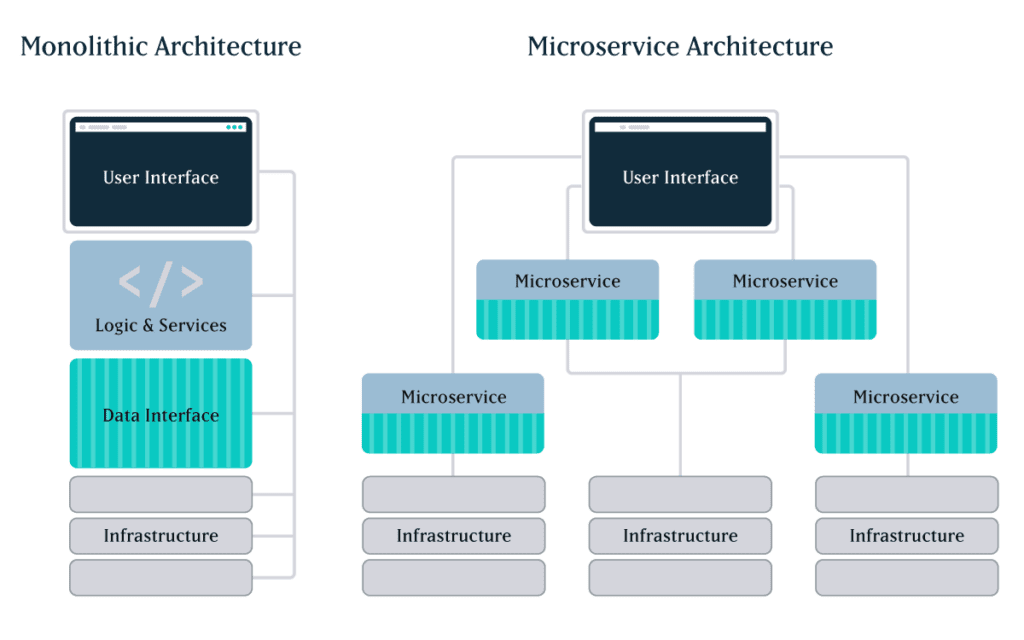
Essentially, with most off-the-shelf monoliths, you get what you get. It may do everything, but not be particularly great at anything. With microservices, by contrast, you can build or cherry-pick optimal applications from the best a given industry has to offer.
Because of their modular nature, microservices make it easier to deploy new functions, scale individual services, and isolate and fix problems. On the other hand, with less complexity and fewer moving parts, monoliths can be cheaper and easier to develop and manage.
So which one is better? As with most things technological, it depends on many factors. Let’s take a look at the benefits and drawbacks of microservices.
Advantages of Microservices Architecture
Companies that embrace microservices see it as a cleaner, faster, and more efficient approach to meeting business needs, such as managing a growing user base, expanding feature sets, and deploying solutions quickly. In fact, there are a number of ways in which microservices beat out monoliths for speed, scale, and agility.
Shorter time to market
Large monolithic applications can take a long time to develop and deploy, anywhere from months to years. That could leave you lagging behind your competitors’ product releases or struggling to respond quickly to user feedback.
By leveraging third-party microservices rather than building your own applications from scratch, you can drastically reduce time to market. And, because the services are compartmentalized, they can be built and deployed independently by smaller, dedicated teams working simultaneously. You also have greater flexibility in finding the right tools for the job: you can choose the best of breed for each service, regardless of technology stack.
Lastly, microservices facilitate the minimum viable product approach. Instead of deploying everything on your wishlist at once, you can roll out core services first and then release subsequent services later.
Faster feature releases
Any changes or updates to monoliths require redeploying the entire application. The bigger a monolith gets, the more time and effort is required for things like updates and new releases.
By contrast, because microservices are independently managed, dedicated teams can iterate at their own pace without disrupting others or taking down the entire system. This means you can deploy new features rapidly and continuously, with little to no risk of impacting other areas of the platform.
This added agility also lets you prioritize and manage feature requests from a business perspective, not a technology perspective. Technology shouldn’t prevent you from making changes that increase user engagement or drive revenue—it should enable those changes.
Affordable scalability
If you need to scale just one service in a monolithic architecture, you’ll have to scale and redeploy the entire application. This can get expensive, and you may not be able to scale in time to satisfy rising demand.
Microservices architecture offers not only greater speed and flexibility, but also potential savings in hosting costs, because you can independently scale any individual service that’s under load. You can also configure a single service to add capability automatically until load need is met, and then scale back to normal capacity.
More support for growth
With microservices architecture, you’re not limited to a UI that’s tethered to your back end. For growing organizations that are continually thinking ahead, this is one of the greatest benefits of microservices architecture.
In the past, websites and mobile apps had completely separate codebases, and launching a mobile app meant developing a whole new application. Today, you just need to develop a mobile UI and connect it to the same service as your website UI. Make updates to the service, and it works across everything.
You have complete control over the UI — what it looks like, how it functions for the customer, etc… You can also test and deploy upgrades without disrupting other services. And, as new forms of data access and usage emerge, you have readily available services that you can use for whatever application suits your needs. Digital signage, voice commands for Alexa… and whatever comes next.
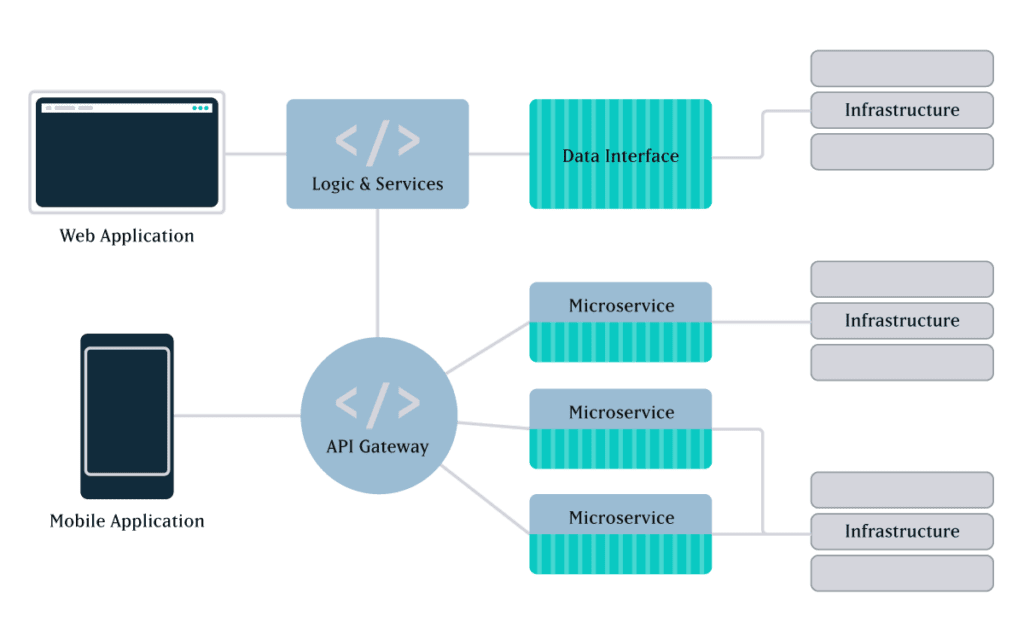
Optimal programming options
Since monolithic applications are tightly coupled and developed with a single stack, all components typically share one programming language and framework. This means any future changes or additions are limited to the choices you make early on, which could cause delays or quality issues in future releases.
Because microservices are loosely coupled and independently deployed, it’s easier to manage diverse datasets and processing requirements. Developers can choose whatever language and storage solution is best suited for each service, without having to coordinate major development efforts with other teams.
Greater resilience
For complex platforms, fault tolerance and isolation are crucial advantages of microservices architecture. There’s less risk of system failure, and it’s easier and faster to fix problems.
In monolithic applications, even just one bug affecting one tiny part of a single feature can cause problems in an unrelated area—or crash the entire application. Any time you make a change to a monolithic application, it introduces risk. With microservices, if one service fails, it’s unlikely to bring others down with it. You’ll have reduced functionality in a specific capacity, not the whole system.
Microservices also make it easier to locate and isolate issues, because you can limit the search to a single software module. Whereas in monoliths, given the possible chain of faults, it’s hard to isolate the root cause of problems or predict the outcome of any changes to the codebase.
Monoliths thus make it difficult and time-consuming to recover from failures, especially since, once an issue has been isolated and resolved, you still have to rebuild and redeploy the entire application. Since microservices allow developers to fix problems or roll back buggy updates in just one service, you’ll see a shorter time to resolution.
Faster onboarding
With smaller, independent code bases, microservices make it faster and easier to onboard new team members. Unlike with monoliths, new developers don’t have to understand how every service works or all the interdependencies at play in the system.
This means you won’t have to scour the internet looking for candidates who can code in the only language you’re using, or spend time training them in all the details of your codebase. Chances are, you’ll find new hires more easily and put them to work faster.
Easier updates
As consumer expectations for digital experiences evolve over time, applications need to be updated or upgraded to meet them. Large monolithic applications are generally difficult, and expensive, to upgrade from one version to the next.
Because third-party app owners build and pay for their own updates, with microservices there’s no need to maintain or enhance every tool in your system. For instance, you get to let Stripe perfect its payment processing service while you leverage the new features. You don’t have to pay for future improvements, and you don’t need anyone on staff to be an expert in payment processing and security.
Disadvantages of Microservices Architecture
Do microservices win in every circumstance? Absolutely not. Monoliths can be a more cost-effective, less complicated, and less risky solution for many applications. Below are a few potential downsides of microservices.
Extra complexity
With more moving parts than monolithic applications, microservices may require additional effort, planning, and automation to ensure smooth deployment. Individual services must cooperate to create a working application, but the inherent separation between teams could make it difficult to create a cohesive end product.
Development teams may have to handle multiple programming languages and frameworks. And, with each service having its own database and data storage system, data consistency could be a challenge.
Also, when you choose to leverage numerous 3rd party services, this creates more network connections as well as more opportunities for latency and connectivity issues in your architecture.
Difficulty in monitoring
Given the complexity of microservices architecture and the interdependencies that may exist among applications, it’s more challenging to test and monitor the entire system. Each microservice requires individualized testing and monitoring.
You could build automated testing scripts to ensure individual applications are always up and running, but this adds time and complexity to system maintenance.
Added external risks
There are always risks when using third-party applications, in terms of both performance and security. The more microservices you employ, the more possible points of failure exist that you don’t directly control.
In addition, with multiple independent containers, you’re exposing more of your system to potential attackers. Those distributed services need to talk to one another, and a high number of inter-service network communications can create opportunities for outside entities to access your system.
On an upside, the containerized nature of microservices architecture prevents security threats in one service from compromising other system components. As we noted in the advantages section above, it’s also easier to track down the root cause of a security issue.
Potential culture changes
Microservices architecture usually works best in organizations that employ a DevOps-first approach, where independent clusters of development and operations teams work together across the lifecycle of an individual service. This structure can make teams more productive and agile in bringing solutions to market. But, at an organizational level, it requires a broader skill set for developing, deploying, and monitoring each individual application.
A DevOps-first culture also means decentralizing decision-making power, shifting it from project teams to a shared responsibility among teams and DevOps engineers. The goal is to ensure that a given microservice meets a solution’s technical requirements and can be supported in the architecture in terms of security, stability, auditing, etc…
3 Paths Toward Microservices Transformation
In general, there are three different approaches to developing a microservices architecture:
1. Deconstruct a monolith
This kind of approach is most common for large enterprise applications, and it can be a massive undertaking. Take Airbnb, for instance: several years ago, the company migrated from a monolith architecture to a service-oriented architecture incorporating microservices. Features such as search, reservations, messaging, and checkout were broken down into one or more individual services, enabling each service to be built, deployed, and scaled independently.
In most cases, it’s not just the monolith that becomes decentralized. Organizations will often break up their development group, creating smaller, independent teams that are responsible for developing, testing, and deploying individual applications.
2. Leverage PBCs
Packaged Business Capabilities, or PBCs, are essentially autonomous collections of microservices that deliver a specific business capability. This approach is often used to create best-of-breed solutions, where many services are third-party tools that talk to each other via APIs.
PBCs can stand alone or serve as the building blocks of larger app suites. Keep in mind, adding multiple microservices or packaged services can drive up costs as the complexity of integration increases.
3. Combine both types
Small monoliths can be a cost-effective solution for simple applications with limited feature sets. If that applies to your business, you may want to build a custom app with a monolithic architecture.
However, there are likely some services, such as payment processing, that you don’t want to have to build yourself. In that case, it often makes sense to build a monolith and incorporate a microservice for any features that would be too costly or complex to tackle in-house.
A Few Words of Caution
Even though they’re called “microservices”, be careful not to get too small. If you break services down into many tiny applications, you may end up creating an overly complex application with excessive overhead. Lots of micro-micro services can easily become too much to maintain over time, with too many teams and people managing different pieces of an application.
Given the added complexity and potential costs of microservices, for smaller platforms with only one UI it may be best to start with a monolithic application and slowly add microservices as you need them. Start at a high level and zoom in over time, looking for specific functions you can optimize to make you stand out.
Lastly, choose your third party services with care. It’s not just about the features; you also need to consider what the costs might look like if you need to scale a particular service.
Final Thoughts: Micro or Mono?
Still trying to decide which architecture is right for your platform? Here are some of the most common scenarios we encounter with clients:
- If time to market is the most important consideration, then leveraging 3rd party microservices is usually the fastest way to build out a platform or deliver new features.
- If some aspect of what you’re doing is custom, then consider starting with a monolith and either building custom services or using 3rd parties for areas that will help suit a particular need.
- If you don’t have a ton of money, and you need to get something up quick and dirty, then consider starting with a monolith and splitting it up later.
Here at Oomph, we understand that enterprise-level software is an enormous investment and a fundamental part of your business. Your choice of architecture can impact everything from overhead to operations. That’s why we take the time to understand your business goals, today and down the road, to help you choose the best fit for your needs.
We’d love to hear more about your vision for a digital platform. Contact us today to talk about how we can help.
How we leveraged Drupal’s native API’s to push notifications to the many department websites for the State.RI.gov is a custom Drupal distribution that was built with the sole purpose of running hundreds of department websites for the state of Rhode Island. The platform leverages a design system for flexible page building, custom authoring permissions, and a series of custom tools to make authoring and distributing content across multiple sites more efficient.
Come work with us at Oomph!
VIEW OPEN POSITIONS
The Challenge
The platform had many business requirements, and one stated that a global notification needed to be published to all department sites in near real-time. These notifications would communicate important department information on all related sites. Further, these notifications needed to be ingested by the individual websites as local content to enable indexing them for search.
The hierarchy of the departments and their sites added a layer of complexity to this requirement. A department needs to create notifications that broadcast only to subsidiary sites, not the entire network. For example, the Department of Health might need to create a health department specific notification that would get pushed to the Covid site, the RIHavens site, and the RIDelivers sites — but not to an unrelated department, like DEM.
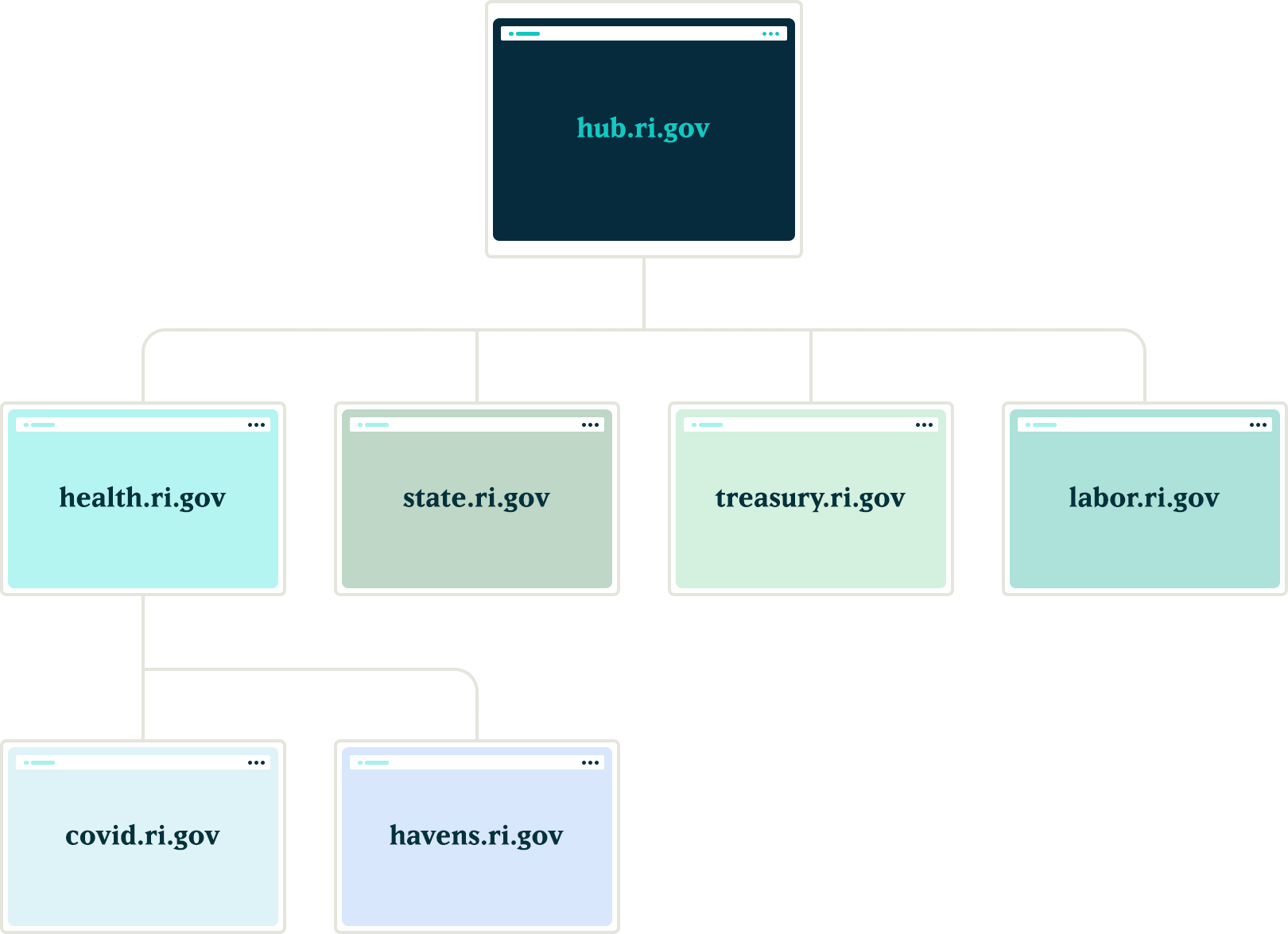
Exploration
Aggregator:
Our first idea was to utilize the built in Drupal aggregator module and pull notifications from the hub. A proof of concept proved that while it worked well for pulling content from the hub site, it had a few problems:
- It relied heavily on the local site’s cron job to pull updates, which led to timing issues in getting the content — it was not in near real-time. Due to server limitations, we could not run cron as often as would be necessary
- Another issue with this approach was that we would need to maintain two entity types, one for global notifications and a second for local site notifications. Keeping local and global notifications as the same entity allowed for easier maintenance for this subsystem.
Feeds:
Another thought was to utilize the Feeds module to pull content from the hub into the local sites. This was a better solution than the aggregator because the nodes would be created locally and could be indexed for local searching. Unfortunately, feeds relied on cron as well.
Our Solution
JSON API
We created a suite of custom modules that centered around moving data between the network sites using Drupal’s JSON API. The API was used to register new sites to the main hub when they came online. It was also used to pass content entities from the main hub down to all sites within the network and from the network sites back to the hub.
Notifications
In order to share content between all of the sites, we needed to ensure that the data structure was identical on all sites in the network. We started by creating a new notification content type that had a title field, a body field, and a boolean checkbox indicating whether the notification should be considered global. Then, we packaged the configuration for this content type using the Features module.
By requiring our new notification feature module in the installation profile, we ensured that all sites would have the required data structure whenever a new site was created. Features also allowed us to ensure that any changes to the notification data model could be applied to all sites in the future, maintaining the consistency we needed.
Network Domain Entity
In order for the main hub, ri.gov, to communicate with all sites in the network, we needed a way to know what Drupal sites existed. To do this, we created a custom configuration entity that stored the URL of sites within the network. Using this domain entity, we were able to query all known sites and passed the global notification nodes created on ri.gov to each known site using the JSON API.
Queue API:
To ensure that the notification nodes were posted to all the sites without timeouts, we decided to utilize Drupal’s Queue API. Once the notification content was created on the ri.gov hub, we queried the known domain entities and created a queue item that would use cron to actually post the notification node to each site’s JSON API endpoint. We decided to use cron in this instance to give us some assurance that a post to many websites wouldn’t timeout and fail.
Batch API
To allow for time sensitive notifications to be pushed immediately, we created a custom batch operation that reads all of the queued notifications and pushes them out one at a time. If any errors are encountered, the notification is re-queued at the end of the stack and the process continues until all notifications have been posted to the network sites.
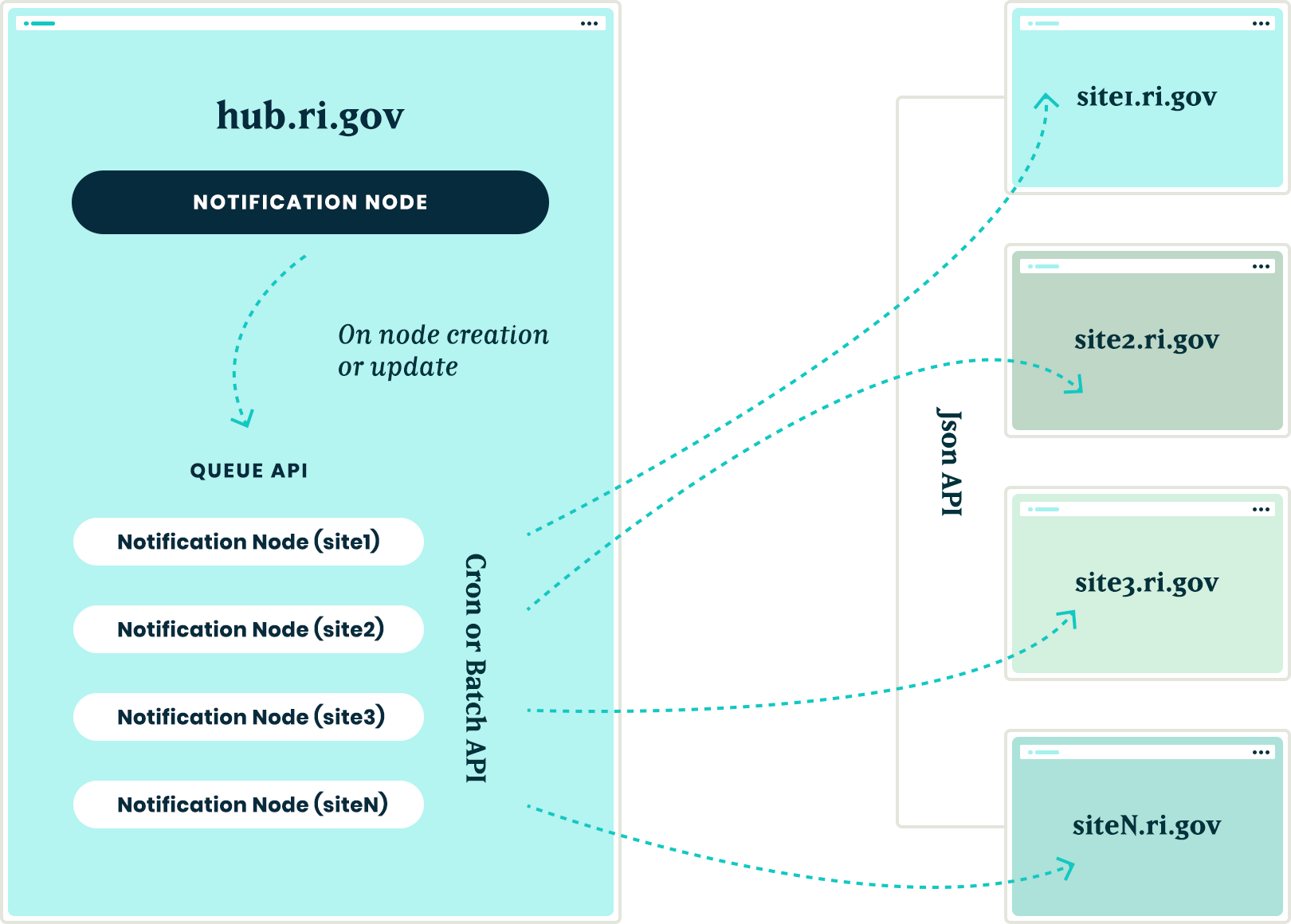
New site registrations
In order to ensure that new sites receive notifications from the hub, we needed a site registration process. Whenever a new site is spun up, a custom module is installed that calls out to the hub using JSON API and registers itself by creating a new network domain entity with it’s endpoint URL. This allows the hub to know of the new site and can push any new notifications to this site in the future.
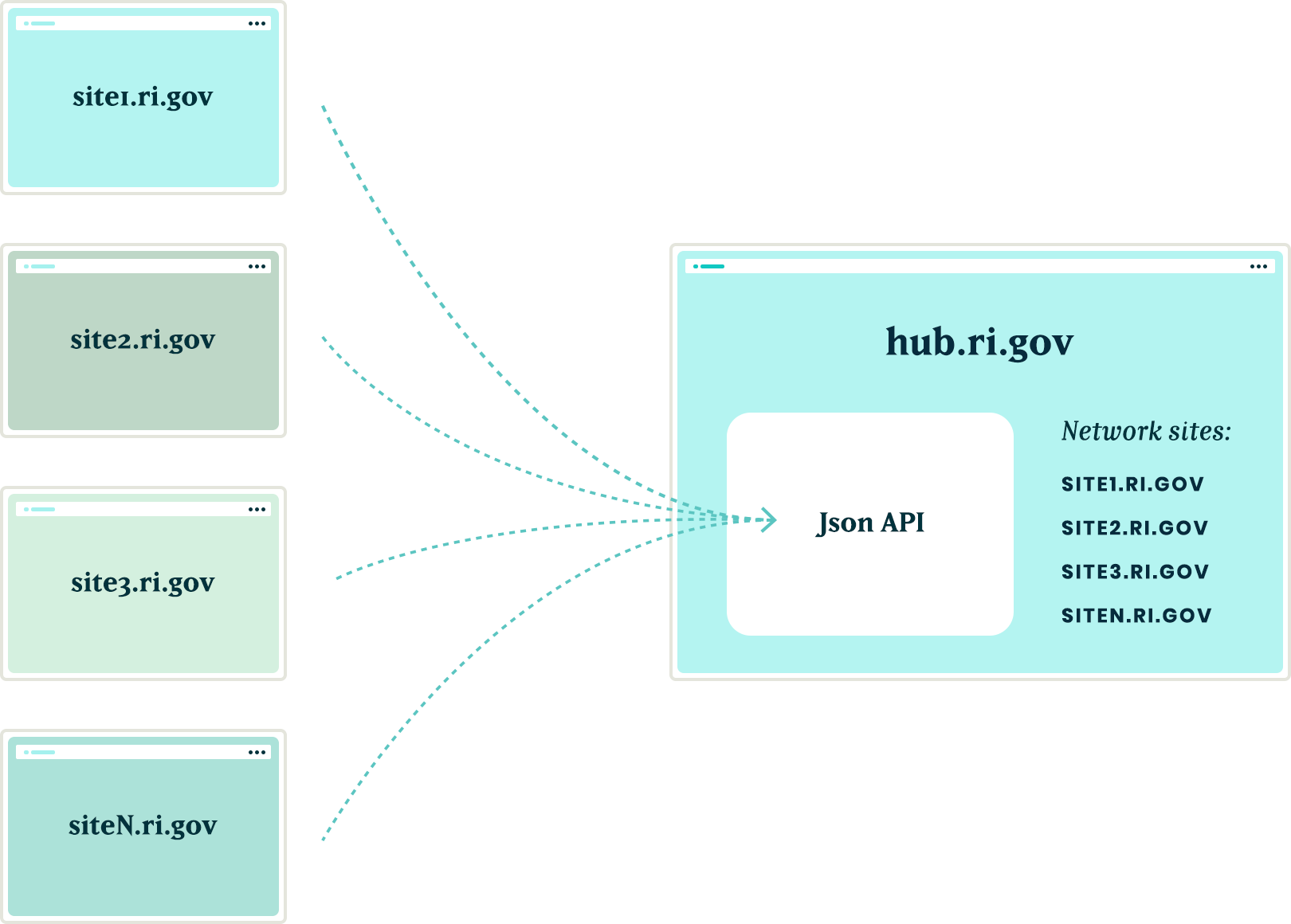
The installation process will also query the hub for any existing notifications and, using the JSON API, get a list of all notification nodes from the hub to add them to it’s local queue for creation. Then, the local site uses cron to query the hub and get the details of each notification node to create it locally. This ensured that when a new site comes online, it will have an up to date list of all the important notifications from the hub.
Authentication
Passing this data between sites is one challenge, but doing it securely adds another layer of complexity. All of the requests going between the sites are authenticating with each other using the Simple Oauth module. When a new site is created, an installation process creates a dedicated user in the local database that will own all notification nodes created with the syndication process. The installation process also creates the appropriate Simple OAuth consumers which allows the authenticated connections to be made between the sites.
Department sites
Once all of the groundwork was in place, with minimal effort, we were able to allow for department sites to act as hubs for their own department sites. Thus, the Department of Health can create notifications that only go to subsidiary sites, keeping them separate from adjacent departments.
Translations
The entire process also works with translations. After a notification is created in the default language, it gets queued and sent to the subsidiary sites. Then, a content author can create a translation of that same node and the translation will get queued and posted to the network of sites in the same manner as the original. All content and translations can be managed at the hub site, which will trickle down to the subsidiary sites.
Moving in the opposite direction
With all of the authorization, queues, batches, and the API’s in place, the next challenge was making this entire system work with a Press Release content type. This provided two new challenges that we needed to overcome:
- Instead of moving content from the top down, we needed to move from the bottom up. Press release nodes get created on the affiliate sites and would need to be replicated on the hub site.
- Press release nodes were more complex than the notification nodes. These content types included media references, taxonomy term references and toughest of all, paragraph references.
Solving the first challenge was pretty simple – we were able to reuse the custom publishing module and instructed the queue API to send the press release nodes to the hub sites.
Getting this working with a complex entity like the press release node meant that we needed to not only push the press release node, but we also needed to push all entities that the initial node referenced. In order for it all to work, the entities needed to be created in reverse order.
Once a press release node was created or updated, we used the EntityInterface referencedEntities() method to recursively drill into all of the entities that were referenced by the press release node. In some cases, this meant getting paragraph entities that were nested two, three, even four levels deep inside of other paragraphs. Once we reached the bottom of the referenced entity pile, we began queuing those entities from the bottom up. So, the paragraph that was nested four levels deep was the first to get sent and the actual node was the last to get sent
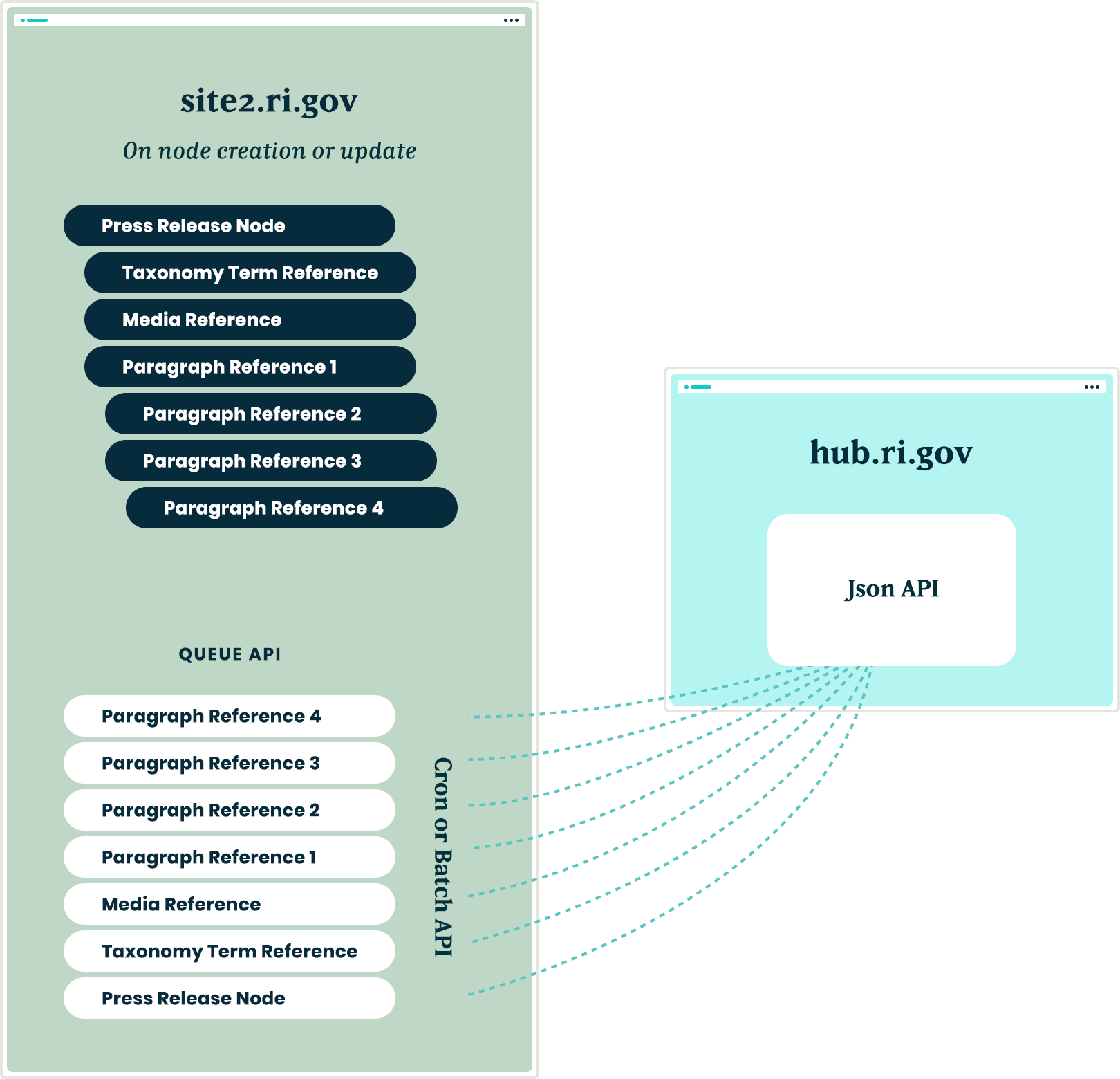
Are you a developer looking to grow your skills? Join our team.
Conclusion
Drupal’s powerful suite of API’s gave us all the tools necessary to come up with a platform that will allow the State of Rhode Island to easily keep their citizens informed of important information, while allowing their editing team the ease of a create once and publish everywhere workflow.
If you live in an area with a lot of freight or commuter trains, you may have noticed that trains often have more than one engine powering the cars. Sometimes it is an engine in front and one in back, or in the case of long freight lines, there could be an engine in the middle. This is known as “Distributed power” and is actually a recent engineering strategy. Evenly distributed power allows them to carry more, and carry it more efficiently.1
When it comes to your website, the same engineering can apply. If the Content Management System (CMS) is the only source of power, it may not have enough oomph to load pages quickly and concurrently for many users. Not only that, but a single source of power may slow down innovation and delivery to multiple sources in today’s multi-channel digital ecosystems.
One of the benefits of decoupled platform architecture is that power is distributed more evenly across the endpoints. Decoupled means that the authoring system and the rendering system for site visitors are not the same. Instead of one CMS powering content authoring and page rendering, two systems handle each task discreetly.
Digital properties are ever growing and evolving. While evaluating how to grow your own system, it’s important to know the difference between coupled and decoupled CMS architectures. Selecting the best structure for your organization will ensure you not only get what you want, but what is best for your entire team — editors, developers, designers, and marketers alike.
Bombardier Zefiro vector graphic designed for Vexels
What is a traditional CMS architecture?
In a traditional, or coupled, CMS, the architecture tightly links the back-end content administration experience to the front-end user experience.
Content creation such as basic pages, news, or blog articles are created, managed, and stored along with all media assets through the CMS’s back end administration screens. The back end is also where site developers create and store customized applications and design templates for use by the front-end of the site.
Essentially, the two sides of the CMS are bound within the same system, storing content created by authenticated users and then also being directly responsible for delivering content to the browser and end users (front end).
From a technical standpoint, a traditional CMS platform is comprised of:
- A private database-driven CMS in which content editors create and maintain content for the site, generally through some CMS administration interfaces we’re used to (think WordPress or Drupal authoring interfaces)
- An application where engineers create and apply design schemas. Extra permissions and features within the CMS give developers more options to extend the application and control the front end output
- A public front end that displays published content on HTML pages
What is a decoupled CMS architecture?
Decoupled CMS architecture separates, or decouples, the back-end and front-end management of a website into two different systems — one for content creation and storage, and another for consuming content and presenting it to the user.
In a decoupled CMS, these two systems are housed separately and work independently of the other. Once content is created and edited in the back end, this front-end agnostic approach takes advantage of flexible and fast web services and APIs to deliver the raw content to any front-end system on any device or channel. It is even possible that an authoring system delivers content to more than front-end (i.e. an article is published in the back-end and pushed out to a website as well as a mobile App).
From a technical standpoint, a decoupled CMS platform is comprised of:
- A private database-driven CMS in which content editors create and maintain content for the site, generally through the same CMS administration interfaces we’re used to — though it doesn’t have to be2
- The CMS provides a way for the front-end application to consume the data. A web-service API — usually in a RESTful manner and in a mashup-friendly format such as JSON — is the most common way
- Popular front-end frameworks such as React, VueJS, or GatsbyJS deliver the public visitor experience via a Javascript application rendering the output of the API into HTML
Benefits of decoupled
By moving the responsibility for the user experience completely into the browser, the decoupled model provides a number of benefits:
Push the envelope
Shifting the end-user experience out of the conventions and structures of the back-end allows UX Engineers and front-end masterminds to push the boundaries of the experience. Decoupled development gives front-end specialists full control using their native tools.
This is largely because traditional back-end platforms have been focused on the flexibility of authoring content and less so on the experience of public visitors. Too often the programming experience slows engineers down and makes it more difficult to deliver an experience that “wows” your users.
Need for speed
Traditional CMS structures are bogged down by “out-of-the-box” features that many sites don’t use, causing unnecessary bloat. Decoupled CMS structures allow your web development team to choose only what code they need and remove what they don’t. This leaner codebase can result in faster content delivery times and can allow the authoring site to load more quickly for your editors.
Made to order
Not only can decoupled architecture be faster, but it can allow for richer interactions. The front-end system can be focused on delivering a truly interactive experience in the form of in-browser applications, potentially delivering content without a visitor reloading the page.
The back-end becomes the system of record and “state machine”, but back-and-forth interaction will happen in the browser and in real-time.
Security Guard
Decoupling the back-end from the front-end is more secure. Since the front-end does not expose its connection to the authoring system, it makes the ecosystem less vulnerable to hackers. Further, depending on how the front-end communication is set up, if the back-end goes offline, it may not interrupt the front-end experience.
In it for the long haul
Decoupled architectures integrate easily with new technology and innovations and allow for flexibility with future technologies. More and more, this is the way that digital platform development is moving. Lean back-end only or “flat file” content management systems have entered the market — like Contentful and Cosmic — while server hosting companies are dealing with the needs of decoupled architecture as well.
The best of both worlds
Decoupled architecture allows the best decisions for two very different sets of users. Content editors and authors can continue to use some of the same CMSs they have been familiar with. These CMSs have great power and flexibility for content modelling and authoring workflows, and will continue to be useful and powerful tools. At the same time, front-end developers can get the power and flexibility they need from a completely different system. And your customers can get the amazing user experiences they have come to expect.
The New Age of Content Management Systems
Today’s modern CMS revolution is driving up demand for more flexible, scalable, customizable content management systems that deliver the experience businesses want and customers expect. Separating the front- and back-ends can enable organizations to quicken page load times, iterate new ideas and features faster, and deliver experiences that “wow” your audience.
- Great article on the distributed power of trains: Why is there an engine in the middle of that train?
- Non-monolithic CMSs have been hitting the market lately, and include products like Contentful, CosmicJS, and Prismic, among others.
Test Driven Development (TDD) facilitates clean and stable code. Drupal 8 has embraced this paradigm with a suite of testing tools that allow a developer to write unit tests, functional tests, and functional JavaScript tests for their custom code. Unfortunately, there is no JavaScript unit testing framework readily available in Drupal core, but don’t fret. This article will show you how to implement JavaScript unit testing.
Why unit test your JavaScript code?
Testing units of code is a great practice, and also guarantees that any future developer doesn’t commit a regression to your logic. Adding unit coverage for JavaScript code is helpful for testing specific logical blocks of code quickly and efficiently without the overhead both in development time and testing time of functional tests.
An example of JavaScript code that would benefit from unit testing would be an input field validator. For demonstration purposes, let’s say you have a field label that permits certain characters, but you want to let the user know immediately if they entered something incorrectly, maybe with a warning message.
Here’s a crude example of a validator that checks an input field for changes. If the user enters a value that is not permitted, they are met with an error alert.
(($, Drupal) => {
Drupal.behaviors.labelValidator = {
attach(context) {
const fieldName = "form.form-class input[name=label]";
const $field = $(fieldName);
$field.on("change", () => {
const currentValue = $field.val();
if (currentValue.length > 0 && !/^[a-zA-Z0-9-]+$/.test(currentValue)) {
alert("The value you entered is incorrect!");
}
});
}
};
})(jQuery, Drupal);
JavaScript
We only allow letters, numbers, and hyphens in this sample validator. We now have a good idea of test data we can create for our test.
Setting up JS Unit Testing
In the world of JavaScript unit testing, Jest has a well-defined feature set, a large community, and is the most popular choice among developers. To begin using Jest, add jest as a development dependency in your favorite manager. Then create a Jest config file, and add your directories for testing. I recommend enabling lcov ; a test coverage reporter that converts test results into local HTML pages.
Writing a Test
We want to test our Drupal behavior, but we need jQuery and the global Drupal object. Have no fear! We can mock all of this. For simplicity’s sake, we can mock both jQuery and Drupal to test the code we want. The point here is to collect the validation logic and run it on our test cases.
There are a couple of different techniques we can use to meet our requirements. You can create a test DOM using a library like JSDOM and require the jQuery library. This gives you the ability to simulate HTML and DOM events. This approach is fine, but our goal is to test our custom validation logic, not to test third-party libraries, or simulate the DOM. Similar to mocking classes and methods in PHPUnit, we can do the same with jest.
Our testing environment is Node, so we can leverage the global object to mock Drupal, jQuery, and even the alert function. Please see Node’s global variable documentation for more information on this object. We can do this in the setup logic of jest with beforeAll:
beforeAll(() => {
global.alert = jest.fn();
global.Drupal = {
behaviors: {}
};
global.jQuery = jest.fn(selector => ({
on(event, callback) {
validator = callback;
},
val() {
return fieldValue;
}
}));
const behavior = require("label-validator.es6.js");
Drupal.behaviors.labelValidator.attach();
});
JavaScript
This makes our behavior available to the global Drupal object. We also have mocked jQuery, so we can collect the callback on which we want to run the tests. We run the attach method on the behavior to collect the callback. You may have noticed that we never declared the validator or fieldValue variables; we do this at the top of our test so we have them available in our tests.
// The validation logic we collect from the `change` event.
let validator = () => "";
// The value of the input we set in our tests.
let fieldValue = "";
JavaScript
With the intention of cleanup, we want to unset all the global objects after we have run our tests. In our case, the globals we are mocking do not exist in Node, so it is safe to set them to null. In cases in which we are mocking defined values, we would want to save a backup of that global and then mock it. After we are done testing, we would set the backup back to its corresponding global. There are also many techniques related to mocking globals and even core Node libraries. For an example, check out the documentation on the jest website.
Here is our tear-down logic. We use the jest function afterAll to achieve this:
afterAll(() => {
global.Drupal = null;
global.jQuery = null;
global.alert = null;
});
JavaScript
We need to create an array of values that we know should pass validation and fail validation. We will call them validLabels and invalidLabels, respectively:
/**
* List of valid labels for the input.
*
* @type {string[]}
*/
const validLabels = [
"123ABVf123",
"123",
"AB",
"1",
"",
"abcdefghijklmnop12345678910",
"ab-3-cd"
];
/**
* List of invalid labels for the input.
*
* @type {string[]}
*/
const invalidLabels = [
"!@#fff",
"test test",
"(123)",
"ABCDEF123!",
"^Y1",
" ",
"'12346'",
];
JavaScript
Finally, we are ready to start writing our tests. We can use jest’s provided test function, or we can use the “describe it” pattern. I prefer the “describe it” pattern because you can provide detailed information on what you are testing and keep it in the same test scope.
Firstly, we want to test our valid data, and we know that these values should never trigger an alert. We will call the validator on each test value and set the expectation that the alert function is never called. But before we write the test, we want to make sure to clear all our mocks between tests to prevent mock pollution. We can achieve this with beforeEach:
beforeEach(() => {
jest.clearAllMocks();
});
JavaScript
After writing our valid data test, we will write our invalid data test. This test should expect an alert for each invalid value sent. Putting it all together we have:
describe("Tests label validation logic", () => {
beforeEach(() => {
jest.clearAllMocks();
});
it("valid label test", () => {
validLabels.forEach(value => {
fieldValue = value;
validator();
});
expect(global.alert.mock.calls.length).toBe(0);
});
it("invalid label test", () => {
invalidLabels.forEach(value => {
fieldValue = value;
validator();
});
expect(global.alert.mock.calls.length).toBe(invalidLabels.length);
});
});
JavaScript
After writing our tests, we can check our coverage and see we have hit 100%!
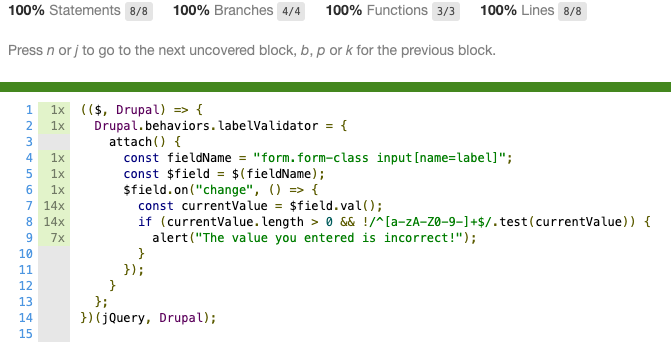
Jest is extremely flexible and has a large ecosystem. There are many different ways we could have achieved the above results; hopefully this gives you some useful ideas on how to unit test your javascript code.
The entire sample Jest test:
/* global test expect beforeEach afterAll beforeAll describe jest it */
// The validation logic we collect from the `change` event.
let validator = () => "";
// The value of the input we set in our tests.
let fieldValue = "";
// the setup function where we set our globals.
beforeAll(() => {
global.alert = jest.fn();
global.Drupal = {
behaviors: {}
};
global.jQuery = jest.fn(selector => ({
on(event, callback) {
validator = callback;
},
val() {
return fieldValue;
}
}));
const behavior = require("label-validator.es6.js");
Drupal.behaviors.labelValidator.attach();
});
// Global tear down function we use to remove our mocks.
afterAll(() => {
global.Drupal = null;
global.jQuery = null;
global.alert = null;
});
/**
* List of valid labels for the input.
*
* @type {string[]}
*/
const validLabels = [
"123ABVf123",
"123",
"AB",
"1",
"",
"abcdefghijklmnop12345678910",
"ab-3-cd"
];
/**
* List of invalid labels for the input.
*
* @type {string[]}
*/
const invalidLabels = [
"!@#fff",
"test test",
"(123)",
"ABCDEF123!",
"^Y1",
" ",
"'12346'",
];
// The tests.
describe("Tests label validation logic", () => {
beforeEach(() => {
jest.clearAllMocks();
});
it("valid label test", () => {
validLabels.forEach(value => {
fieldValue = value;
validator();
});
expect(global.alert.mock.calls.length).toBe(0);
});
it("invalid label test", () => {
invalidLabels.forEach(value => {
fieldValue = value;
validator();
});
expect(global.alert.mock.calls.length).toBe(invalidLabels.length);
});
});
JavaScript
Resources
- Jest javascript testing framework – jest
- NPM trends JS testing framework popularity – npm trends js testing
- Jest configuration file documentation – https://jestjs.io/docs/en/configuration.html
- A JS DOM testing library – JSDOM
- Jest mocking documentation – jestjs.io/docs/en/manual-mocks
This post will assume you have already completed the base setup of enabling Layout Builder and added the ability to manage layouts to one of your content types. If you are not to this point check out Drupal.orgs documentation on layout builder or this article by Tyler Fahey which goes over setup and some popular contrib module enhancements.
As we mentioned in part 1 of this series, you should expect a little DIY with Layout Builder. So far the best way we have found to theme Layout Builder is by creating a custom module to provide our own custom layouts and settings. By defining custom layouts in a custom module we get the ability to control each layout’s markup as well as the ability to add/remove classes based on the settings we define.
Writing the custom layout module
Setup the module
Start by creating your custom module and providing the required .info.yml file.
demo_layout.info.yml:
name: Demo Layout
description: Custom layout builder functionality for our theme.
type: module
core: 8.x
package: Demo
dependencies:
- drupal:layout_builder
YAML
Remove default core layouts
Layout Builder comes with some standard layouts by default. There’s nothing wrong with these, but generally for our clients, we want them only using our layouts. This hook removes those core layouts, leaving only the layouts that we will later define:
demo_layout.module
/**
* Implements hook_plugin_filter_TYPE__CONSUMER_alter().
*/
function demo_layout_plugin_filter_layout__layout_builder_alter(array &$definitions): void {
// Remove all non-demo layouts from Layout Builder.
foreach ($definitions as $id => $definition) {
if (!preg_match('/^demo_layout__/', $id)) {
unset($definitions[$id]);
}
}
}
PHP
Register custom layouts and their regions
The next step is to register the custom layouts and their respective regions. This process is well documented in the following drupal.org documentation: https://www.drupal.org/docs/8/api/layout-api/how-to-register-layouts
For this particular demo module we are going to define a one column and a two column layout. These columns will be able to be sized later with the settings we provide.
demo_layout.layouts.yml
demo_layout__one_column:
label: 'One Column'
path: layouts/one-column
template: layout--one-column
class: Drupal\demo_layout\Plugin\Layout\OneColumnLayout
category: 'Columns: 1'
default_region: first
icon_map:
- [first]
regions:
first:
label: First
demo_layout__two_column:
label: 'Two Column'
path: layouts/two-column
template: layout--two-column
class: Drupal\demo_layout\Plugin\Layout\TwoColumnLayout
category: 'Columns: 2'
default_region: first
icon_map:
- [first, second]
regions:
first:
label: First
second:
label: Second
YAML
Pay close attention to the path, template, and class declarations. This determines where the twig templates and their respective layout class get placed.
Creating the base layout class
Now that we have registered our layouts, it’s time to write a base class that all of the custom layouts will inherit from. For this demo we will be providing the following settings:
- Column width
- Column padding (top and bottom)
- Background color
- Custom classes
However, there is a lot of PHP to make this happen. Thankfully for the most part it follows a general pattern. To make it easier to digest, we will break down each section for the Column Width setting only and then provide the entire module at the end which has all of the settings.
src/Plugin/Layout/LayoutBase.php
<?php
declare(strict_types = 1);
namespace Drupal\demo_layout\Plugin\Layout;
use Drupal\demo_layout\DemoLayout;
use Drupal\Core\Form\FormStateInterface;
use Drupal\Core\Layout\LayoutDefault;
/**
* Provides a layout base for custom layouts.
*/
abstract class LayoutBase extends LayoutDefault {
}
PHP
Above is the layout class declaration. There isn’t a whole lot to cover here other than to mention use Drupal\demo_layout\DemoLayout;. This class isn’t necessary but it does provide a nice one-stop place to set all of your constant values. An example is shown below:
src/DemoLayout.php
<?php
declare(strict_types = 1);
namespace Drupal\demo_layout;
/**
* Provides constants for the Demo Layout module.
*/
final class DemoLayout {
public const ROW_WIDTH_100 = '100';
public const ROW_WIDTH_75 = '75';
public const ROW_WIDTH_50 = '50';
public const ROW_WIDTH_25 = '25';
public const ROW_WIDTH_25_75 = '25-75';
public const ROW_WIDTH_50_50 = '50-50';
public const ROW_WIDTH_75_25 = '75-25';
}
PHP
The bulk of the base class logic is setting up a custom settings form using the Form API. This form will allow us to formulate a string of classes that get placed on the section or to modify the markup depending on the form values. We are not going to dive into a whole lot of detail as all of this is general Form API work that is well documented in other resources.
Setup the form:
/**
* {@inheritdoc}
*/
public function buildConfigurationForm(array $form, FormStateInterface $form_state): array {
$columnWidths = $this->getColumnWidths();
if (!empty($columnWidths)) {
$form['layout'] = [
'#type' => 'details',
'#title' => $this->t('Layout'),
'#open' => TRUE,
'#weight' => 30,
];
$form['layout']['column_width'] = [
'#type' => 'radios',
'#title' => $this->t('Column Width'),
'#options' => $columnWidths,
'#default_value' => $this->configuration['column_width'],
'#required' => TRUE,
];
}
$form['#attached']['library'][] = 'demo_layout/layout_builder';
return $form;
}
/**
* {@inheritdoc}
*/
public function validateConfigurationForm(array &$form, FormStateInterface $form_state) {
}
/**
* {@inheritdoc}
*/
public function submitConfigurationForm(array &$form, FormStateInterface $form_state) {
$this->configuration['column_width'] = $values['layout']['column_width'];
}
/**
* Get the column widths.
*
* @return array
* The column widths.
*/
abstract protected function getColumnWidths(): array;
PHP
Finally, we add the build function and pass the column width class:
/**
* {@inheritdoc}
*/
public function build(array $regions): array {
$build = parent::build($regions);
$columnWidth = $this->configuration['column_width'];
if ($columnWidth) {
$build['#attributes']['class'][] = 'demo-layout__row-width--' . $columnWidth;
}
return $build;
}
PHP
Write the column classes
Now that the base class is written, we can write column-specific classes that extend it. These classes are very minimal since most of the logic is contained in the base class. All that is necessary is to provide the width options for each individual class.
src/Plugin/Layout/OneColumnLayout.php
<?php
declare(strict_types = 1);
namespace Drupal\demo_layout\Plugin\Layout;
use Drupal\demo_layout\DemoLayout;
/**
* Provides a plugin class for one column layouts.
*/
final class OneColumnLayout extends LayoutBase {
/**
* {@inheritdoc}
*/
protected function getColumnWidths(): array {
return [
DemoLayout::ROW_WIDTH_25 => $this->t('25%'),
DemoLayout::ROW_WIDTH_50 => $this->t('50%'),
DemoLayout::ROW_WIDTH_75 => $this->t('75%'),
DemoLayout::ROW_WIDTH_100 => $this->t('100%'),
];
}
/**
* {@inheritdoc}
*/
protected function getDefaultColumnWidth(): string {
return DemoLayout::ROW_WIDTH_100;
}
}
PHP
src/Plugin/Layout/TwoColumnLayout.php
<?php
declare(strict_types = 1);
namespace Drupal\demo_layout\Plugin\Layout;
use Drupal\demo_layout\DemoLayout;
/**
* Provides a plugin class for two column layouts.
*/
final class TwoColumnLayout extends LayoutBase {
/**
* {@inheritdoc}
*/
protected function getColumnWidths(): array {
return [
DemoLayout::ROW_WIDTH_25_75 => $this->t('25% / 75%'),
DemoLayout::ROW_WIDTH_50_50 => $this->t('50% / 50%'),
DemoLayout::ROW_WIDTH_75_25 => $this->t('75% / 25%'),
];
}
/**
* {@inheritdoc}
*/
protected function getDefaultColumnWidth(): string {
return DemoLayout::ROW_WIDTH_50_50;
}
}
PHP
We can now check out the admin interface and see our custom form in action.
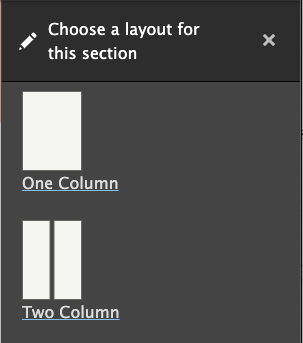
One column options:
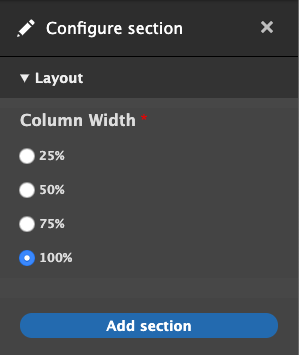
Two column options:
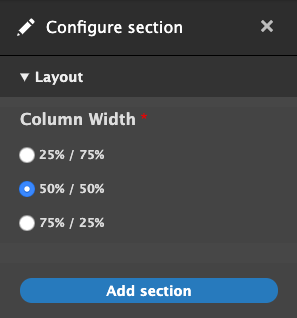
Add twig templates
The last step is to provide the twig templates that were declared earlier in the demo_layout.layouts.yml file. The variables to be aware of are:
- Content: contains the block content for this layout separated by region
- Attributes: contains the custom classes that were passed in the base class build function.
- Settings:contains the submitted form values from the settings form.
src/layouts/one-column/layout–one-column.html.twig
{#
/**
* @file
* Default theme implementation to display a one-column layout.
*
* Available variables:
* - content: The content for this layout.
* - attributes: HTML attributes for the layout <div>.
* - settings: The custom form settings for the layout.
*
* @ingroup themeable
*/
#}
{%
set row_classes = [
'row',
'demo-layout__row',
'demo-layout__row--one-column'
]
%}
{% if content %}
<div{{ attributes.addClass( row_classes|join(' ') ) }}>
<div {{ region_attributes.first.addClass('column', 'column--first') }}>
{{ content.first }}
</div>
</div>
{% endif %}
Twig
src/layouts/two-column/layout–two-column.html.twig
{#
/**
* @file
* Default theme implementation to display a two-column layout.
*
* Available variables:
* - content: The content for this layout.
* - attributes: HTML attributes for the layout <div>.
* - settings: The custom form settings for the layout.
*
* @ingroup themeable
*/
#}
{# Get the column widths #}
{% set column_widths = settings.column_width|split('-') %}
{%
set row_classes = [
'row',
'demo-layout__row',
'demo-layout__row--two-column'
]
%}
{% if content %}
<div{{ attributes.addClass( row_classes|join(' ') ) }}>
{% if content.first %}
<div {{ region_attributes.first.addClass('column', 'column--' ~ column_widths.0, 'column--first') }}>
{{ content.first }}
</div>
{% endif %}
{% if content.second %}
<div {{ region_attributes.second.addClass('column', 'column--' ~ column_widths.1, 'column--second') }}>
{{ content.second }}
</div>
{% endif %}
</div>
</div>
{% endif %}
Twig
Notice settings.column_width was passed with a string: 75-25. We need to split it and place each value on our column which results in the following output.
<div class="demo-layout__row-width--75-25 row demo-layout__row demo-layout__row--two-column ">
<div class="column column--75 column--first"></div>
<div class="column column--25 column--second"></div>
</div>
HTML
Since these are custom classes, and we haven’t written any CSS, these columns do not have any styling. Depending on your preference, you can implement your own custom column styles or wire up a grid framework such as Bootstrap in order to get the columns to properly size themselves.
Wrapping it up
You should be at a point where you have an idea of how to create custom settings in order to theme layout builder sections. You can take this method and extend it however you need to for your particular project. There’s no definitive best way to do anything in the world of web development, and Layout Builder is no exception to that rule. It’s a great addition to Drupal’s core functionality, but for larger sites, it likely won’t be and shouldn’t be the only way you handle layout. Much like Drupal itself though, as more and more people use it, Layout Builder will only become stronger, more robust, more fully-featured, and better documented. If it doesn’t seem like a good fit for you right now, it may become a better fit as it grows. If it does seem like a good fit, be ready to get your hands dirty!
The full demo layouts module with all of the custom settings is available here: https://github.com/oomphinc/layout-builder-demo/tree/master/moduleexamples/demolayout
Maintaining logins for numerous platforms can become a headache over time. This is especially the case for an organization where members join and leave often. On- and off-boarding can become a hassle to manage.
For one of our clients, we needed a better way to control application privileges. If a new team member was starting, our team would manually create new accounts. Then if someone left their company or ours, we would manually remove their account from the infrastructure. This was not only an extra set of tasks which require time to accomplish, but also a potential point of failure where forgetting to remove a former team member’s access.
Single-sign-on to the Rescue
Single-sign-on (SSO) is something that almost all internet users have encountered, whether or not they know it. Logging in to Instagram with your Facebook account, or signing in to any number of Android apps with your Google account are some easy examples.
To the user, this is much easier than creating a new account and filling in yet another registration form — and keeping track of one more password. In these cases, your identity is maintained by one entity (Facebook or Google) and used to populate your account information on a service provider (Instagram or Android).
SSO as a De-provisioning Tool
In a business environment, the relationship between the Identity Provider (IdP) and Service Provider (SP) has a very useful feature — if the account is removed on the IdP’s side, that user will no longer be able to access the SP application. This makes de-provisioning users a single-step process.
At Oomph, we use Google’s G Suite for email, calendars, and their productivity Apps. If we could use our Google accounts to sign in to, say, Evernote, why couldn’t we also use our Google identity to control access to our client projects?
Getting Google and Okta to Shake Hands
Our client in this example had been using <a href=”//www.okta.com”target=”_blank” rel=”noopener noreferrer” title=”Opens in a new window”>Okta as their SSO provider. In our experience, they have been pretty great to work with. Through Okta, we can control access to various entities — from logins for end users on the web application, to client access to their CMS, to access control for the GitHub organization where the code repository is hosted.

Up until this point however, we had always created accounts and signed in to Okta manually — like cave people. There had to be a better way. By using Google as our own Identity Provider to manage access to Okta, and through that, our client’s environments, we could have a single source of truth and much easier provisioning/deprovisioning.
Less than Stellar Documentation
The internet and Google have amazingly detailed and accurate tutorials for a lot of things, but not everything. As is the case sometimes, the documentation on these matters was thin or confusing or just plain wrong. At points we found that we started reading about how to set Google as an IdP, only to later realize that the documents appeared to discuss the reverse relationship — using Okta as an IdP for Google Apps.
After some trial and error, we were able to get a successful handshake between the two. We may have created the digital equivalent of Scrödinger’s cat in the process, but that’s a story for another time. Here is how we did it.
How to Set up Google as an IdP with Okta SSO
Okta does have a Google-specific Identity Provider type, however, it led us down a path where we ended up with an Identity Provider which both existed and didn’t exist at the same time (the aforementioned Scrödinger’s cat). As such, we found the easiest method was to use a standard SAML 2.0 Identity Provider. These exact steps are for setting up a connection to Okta — these basic principles should also apply to any SSO service provider which can use SAML 2.0. With that background, let’s get started:
In Okta, navigate to the admin panel, and from here, select Identity Providers under the Security tab
Press “Add Identity Provider” and then “Add SAML 2.0 IdP” from the dropdown
Here you will have a number of options to configure, and many will depend on your own setup. Some important ones are:
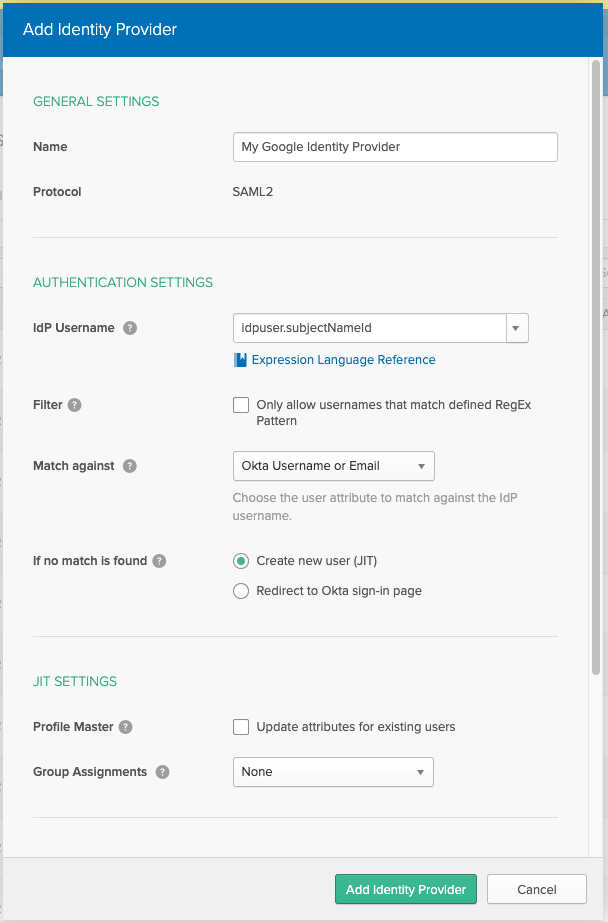
- Name: give your Identity Provider an appropriate name
- IdP Username: typically idpuser.subjectNameId will suit your needs
- An extra hurdle we encountered for our own use case was the fact that at Oomph, some years ago we migrated to a new domain — while we typically use “oomphinc.com” these days, all of our previous accounts were set up with a legacy email root in place. Google still sees our legacy domain as the primary, and as such, would attempt to provision new (incorrect) users for us. Many fields in Okta allow the use of their expression engine. Leveraging this, we were able to set our IdP Username field as follows:
String.replace(idpuser.subjectNameId, "legacy", "preferred")meaning that while Google is sending “jdoe@legacy.com”, the Okta account will be created as “jdoe@preferred.com”
- An extra hurdle we encountered for our own use case was the fact that at Oomph, some years ago we migrated to a new domain — while we typically use “oomphinc.com” these days, all of our previous accounts were set up with a legacy email root in place. Google still sees our legacy domain as the primary, and as such, would attempt to provision new (incorrect) users for us. Many fields in Okta allow the use of their expression engine. Leveraging this, we were able to set our IdP Username field as follows:
- Match against: Okta Username or email
- Profile Master: This will depend on the use case. It refers back to the idea that if a user’s information is changed in Google, their Okta profile will be updated to match. If left unchecked, the user may update their information in Okta without it being overwritten on their next login
- Group assignments: Whether to assign the user to Okta groups — either a static group (or groups) for all users. With the option “Full sync of groups” and an attribute name as well as a list of groups in the Group Filter, an attribute can be sent by the IdP containing the name of the group a user should be assigned to if it is in the Group Filter list.
For now, leave the Okta IdP configuration screen open, and it is time to hop over to your Google admin.google.com
Navigate to Apps -> SAML Apps
Add a new app with the “+” in the bottom right corner of the screen
In the modal, select “Setup my own custom app” at the bottom of the pop up
Copy SSO URL, Entity ID and download the certificate
Return to the Okta setup page, and enter the values from G Suite for the IdP Single Sign-On URL (SSO URL), IdP Issuer URI (Entity ID), and upload the certificate downloaded from Google
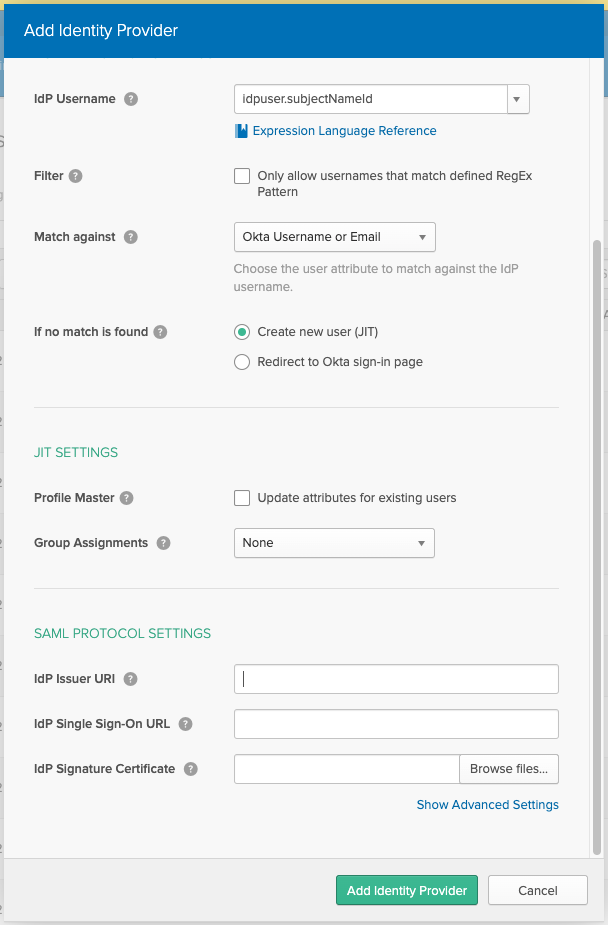
Press “Add Identity Provider” in Okta
On the Identity Provider screen in Okta, expand the new Identity Provider, and copy the Assertion Consumer Service URL and Audience URI values
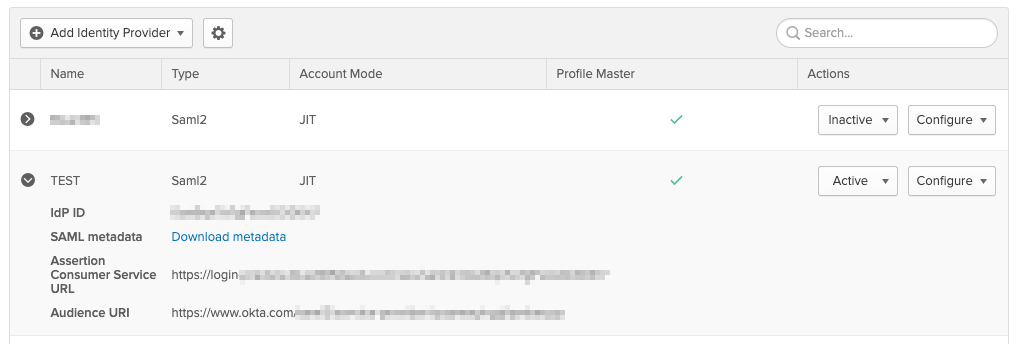
Return to Google, enter a name for your application, and optionally add a description and logo, then navigate to the next step
On this step, enter the ACS URL (Assertion Consumer Service URL from Okta) and Entity ID (Audience URI from Okta)
Leave the Start URL blank
Check the Signed Response box
Leave the Name ID values as defaults
Set Name ID Format to “EMAIL”
Press “Next” to move on to attribute mapping. This will depend entirely on your own needs. The left column will be the field names expected by your Okta configuration. This is the profile data which will be sent from Google to Okta when creating or updating the user account in Okta
At this point you should have the basics configured to connect to Okta with Google as an Identity Provider. Press “Finish” to save the configuration in Google. From here you can grant access to users in your Google organization. Your app should now appear at gsuite.google.com/dashboard and selecting your new application should bring you to Okta and sign you in automatically, granting access to any Okta managed applications.
Good Luck with your Configuration
The convenience of the connection between Google and Okta for our organization and our client’s can’t be denied. We are so glad to have this set up. But it took some doing, particularly when the documentation we were able to find was incomplete. We hope this info can help your organization get these two talking to each other.
Can your organization benefit from a fine-tuned SSO or SAML connection? Drop us a line with questions or requests.
Note: This blog post is NOT about Voting in Iowa and an App that failed to do its job. But if anyone wants an opinion on how that App should have been built and how much it should have cost, drop us a line 🙂
The great thing about the open source community around Drupal is the range of complex features that already exist. Sometimes, though, the documentation on how to use those pre-built pieces of functionality is lacking. That’s a situation we found ourselves in recently with Drupal’s Voting API.
We found a great tutorial for implementing the Voting API without any customization. Drupalize.Me also has helpful instructional video and text. But if you want to extend the module programmatically, there is very little material online to help guide the way.
The Problem to Solve
Oomph needed to launch a national crowd-sourcing contest for a long-time client. We had to provide visitors with a chance to submit content, and we needed to enable a panel of judges to vote on that content and determine a winner. But behind the scenes, we had to add functionality to enable voting according to specific criteria that our client wanted to enforce. For moderation, there would be an admin page that displays all entries, the scores from all judges, and the ability to search and sort.
Oh, and we had to turn it around in three months — maybe we should have led with that requirement. 😊
Architecting the Solution
Drupal 8 was a natural fit for rendering forms to the user and collecting the input for judging. A few contributed modules got us closer to the functionality we wanted — webform, webformcontentcreator, fivestar, votingapi, and votingapi_widgets.
The robust framework of the Voting API has been around since Drupal 4, so it was a great foundation for this project. It made no sense to build our own voting system when one with a stable history existed. Customizing the way that the API worked put up some roadblocks for our engineering team, however, and the lack of documentation around the API did not help. We hope that by sharing what we learned along the way, we can support the community that maintains the Voting API.
The Lifecycle of the Contest
Submission
The submission form we created is, at its base, a multi-step Webform. It is divided into three pages of questions and includes input for text, images, and video. The form wizard advances users from page to page, with the final submittal kicking off additional processes. A visitor can save an incomplete submission and return to it later. The Webform module contains all of these features, and it saved our team a lot of work.
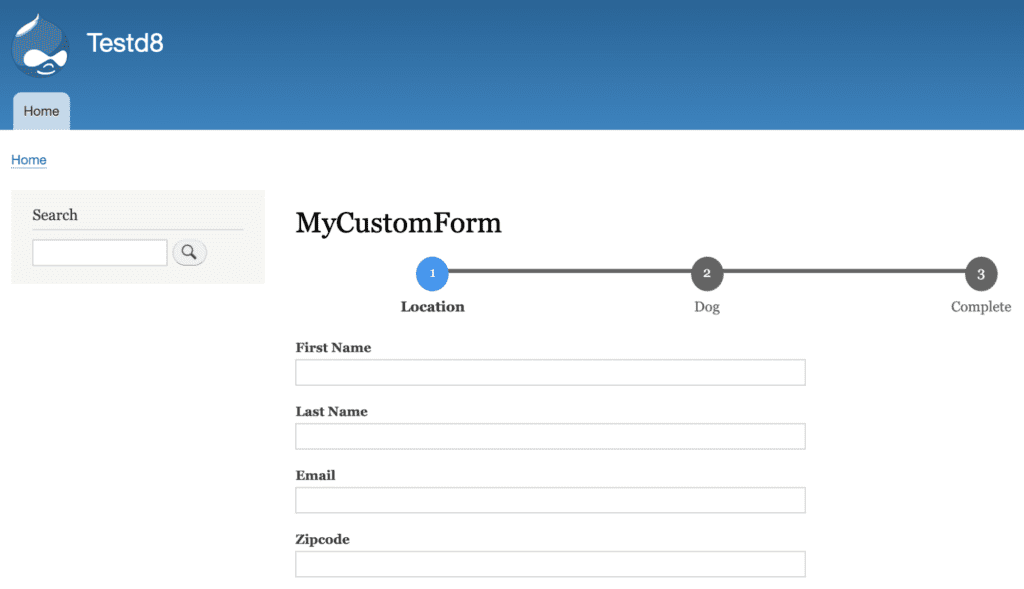
After pressing Submit, there is some custom pre-processing that happens. In this case, we needed to execute a database lookup for one of the submitted fields. Below is an example of code that can be added to a custom module to look up a value and save it to the recently submitted webform. This is a basic code template and won’t include sanitizing user input or all the checks you might need to do on a production-level implementation.
The code snippet and other examples from this blog post are available on Github as a Gist: gist.github.com/bookworm2000/cd9806579da354d2dd116a44bb22b04c.
use \Drupal\webform\Entity\WebformSubmission;
/**
* Implements hook_ENTITY_TYPE_presave().
*/
function mymodule_webform_submission_presave(WebformSubmission $submission) {
// Retrieve the user input from the webform submission.
$submitted_data = $submission->getData();
$zipcode = $submitted_data['zipcode'];
// Retrieve the state name from the database custom table.
// This is calling a service included in the mymodule.services.yml file.
$state_lookup = \Drupal::service('mymodule.state_lookup');
$state_name = $state_lookup->findState($zipcode);
if ($state_name) {
// Update the webform submission state field with the state name.
$submitted_data['state'] = $state_name;
$submission-&gt;setData($submitted_data);
}
}
PHP
Content Entry
The Webform Content Creator module allows you to map fields from a submission to a specified content type’s fields. In our case, we could direct all the values submitted by the contestant to be mapped to our custom Submission content type — every time a user submitted an entry, a new node of content type Submission was created, with all the values from the webform populated.
id: dog_contest_submission_content_creator
title: 'Dog Contest Submission Content Creator'
webform: mycustomform
content_type: dog_contest_submission
field_title: 'Dog Contest - [webform_submission:values:name]'
use_encrypt: false
encryption_profile: ''
elements:
field_email:
type: false
webform_field: email
custom_check: false
custom_value: ''
field_dog_breed:
type: false
webform_field: dog_breed
custom_check: false
custom_value: ''
field_dog_name:
type: false
webform_field: dog_name
custom_check: false
custom_value: ''
field_dog_story:
type: false
webform_field: the_funniest_thing_my_dog_ever_did
custom_check: false
custom_value: ''
YAML
Voting
The main technical obstacle was that there were no voting widgets that fit the project requirements exactly:
- The client wanted a voting field to display on each submission with a dropdown list of numbers 1 through 10
- The default value for the field should be 1 on the first time a judge accessed the submission page
- Any other time the judge viewed the submission, the voting field value should default to the number the judge gave (i.e. 9 out of 10)
- The voting had to support multiple judges, such that the field value would display with the individual score given by each individual judge
The Fivestar contributed module is the module used most often on Drupal sites to implement the Voting API. It is extensible enough to allow developers or designers to add custom icons and customized CSS. The basic structure of the widget is always the same, unfortunately, and was not suitable for our contest. The available widget options are default stars, small stars, small circles, hearts, flames, or “Craft,” as shown:
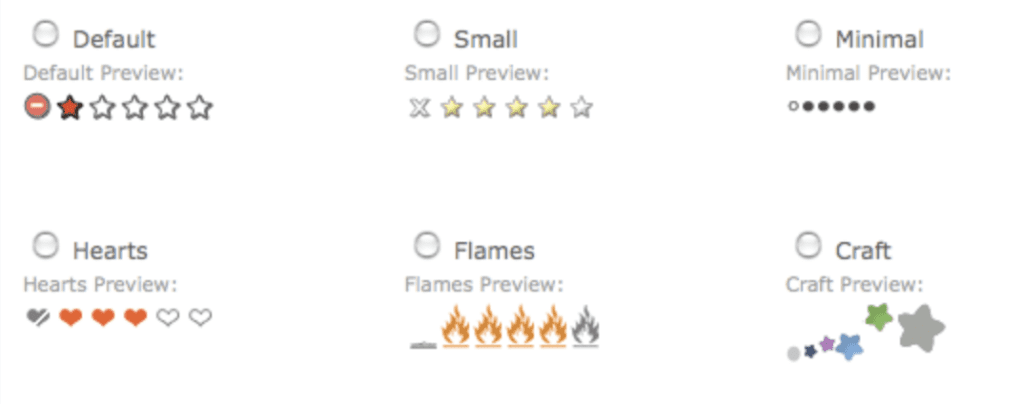
We enabled the Fivestar module and opted to override the base widget in order to implement a new one.
Technical Deep Dive
After enabling the Voting API Widgets module, we could now add our voting field to the submission content type. (Add a field of type “Fivestar Rating” if you want to try out the Fivestar module’s custom field.)
Note: we used the Voting API Widgets 8.x-1.0-alpha3 release. There is now already an alpha5 release that introduces some structural (breaking!) changes to the base entity form that conflict with our custom solution. Job security!
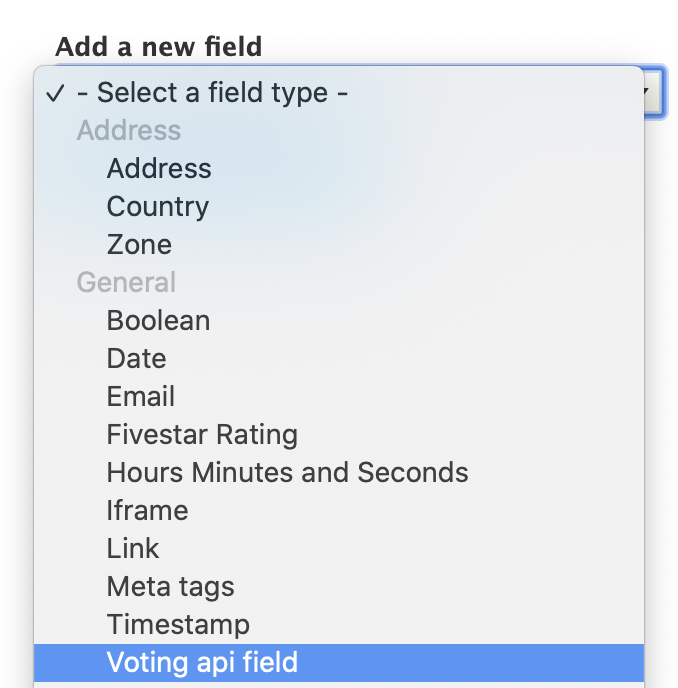
In the field settings for the new Voting API field, the only plugin choices available are plugins from the Fivestar module.
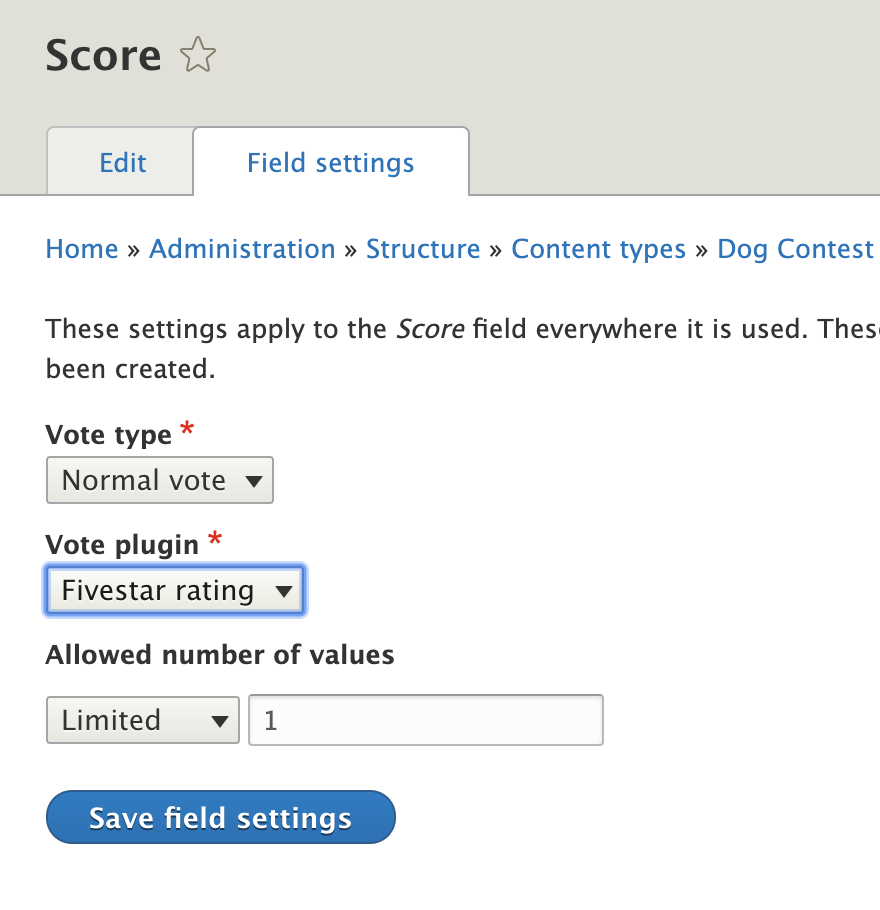
We could not use those plugins for our use case, so we went ahead and built a custom plugin to extend the VotingApiWidgetBase class. For the purpose of this example, let’s call it “SpecialWidget.”
Additionally, we needed to have the ability to set defaults for the voting widget. For that, we had to add a custom form that extends the BaseRatingForm class. The example class here is called “TenRatingForm,” since the voting widget will display a 1-to-10 dropdown list for the judges.
The file structure for the directories and files in the custom module reads like this:
modules
- contrib
- custom
-- mymodule
--- src
---- Form
----- TenRatingForm.php
---- Plugin
----- votingapi_widget
------ SpecialWidget.php
---- StateLookup.php
--- mymodule.info.yml
--- mymodule.module
--- mymodule.services.yml
Let’s look at the SpecialWidget.php file in more detail. It is fairly straightforward, composed of a namespace, class declaration, and 2 inherited methods.
The namespace references the custom module. The annotation sets the widget values list, so you can adjust easily to add your own content. It is critical to include a “use” statement to incorporate the VotingApiWidgetBase class, or else the buildForm( and getStyles() methods from the parent class will not be found, and angry error messages will show up when you try to use your new custom voting widget.
namespace Drupal\mymodule\Plugin\votingapi_widget;
use Drupal\votingapi_widgets\Plugin\VotingApiWidgetBase;
/**
* Custom widget for voting.
*
* @VotingApiWidget(
* id = "special",
* label = @Translation("Special rating"),
* values = {
* 1 = @Translation("1"),
* 2 = @Translation("2"),
* 3 = @Translation("3"),
* 4 = @Translation("4"),
* 5 = @Translation("5"),
* 6 = @Translation("6"),
* 7 = @Translation("7"),
* 8 = @Translation("8"),
* 9 = @Translation("9"),
* 10 = @Translation("10"),
* },
* )
*/
PHP
The other important section to point out is defining the class and the buildForm() method. The SpecialWidget class will now inherit the methods from VotingApiWidgetBase, so you do not need to copy all of them over.
class SpecialWidget extends VotingApiWidgetBase {
/**
* Vote form.
*/
public function buildForm($entity_type, $entity_bundle, $entity_id, $vote_type, $field_name, $style, $show_results, $read_only = FALSE): array {
$form = $this->getForm($entity_type, $entity_bundle, $entity_id, $vote_type, $field_name, $style, $show_results, $read_only);
$build = [
'rating' => [
'#theme' => 'container',
'#attributes' => [
'class' => [
'votingapi-widgets',
'special',
($read_only) ? 'read_only' : '',
],
],
'#children' => [
'form' => $form,
],
],
];
return $build;
}
}
PHP
One additional crucial step is overriding the order of operations with which the entity builds occur. The Voting API Widgets module takes precedence over custom modules, so it is necessary to strong-arm your module to the front to be able to see changes. Ensure that the custom plugin is being called by the Voting API Widgets module, and then also ensure that the mymodule_entity_type_build() in the custom module takes precedence over the votingapi_widgets_entity_type_build() call. These functions go in the mymodule.module file.
/**
* Implements hook_entity_type_build().
*/
function mymodule_entity_type_build(array &$entity_types) {
$plugins = \Drupal::service('plugin.manager.voting_api_widget.processor')->getDefinitions();
foreach ($plugins as $plugin_id => $definition) {
// Override the votingapi_widgets form class for the custom widgets.
if ($plugin_id === 'special') {
$entity_types['vote']->setFormClass('votingapi_' . $plugin_id,
'Drupal\mymodule\Form\TenRatingForm');
}
}
}
/**
* Implements hook_module_implements_alter().
*/
function mymodule_module_implements_alter(array &$implementations, string $hook) {
if ($hook === 'entity_type_build') {
$group = $implementations;
$group = $implementations['mymodule'];
unset($implementations['mymodule']);
$implementations['mymodule'] = $group;
}
}
PHP
After adding the custom plugin to the custom module, the option to select the widget will be available for use by the Voting API field. (After clearing all caches, of course.) The field here is called Score.
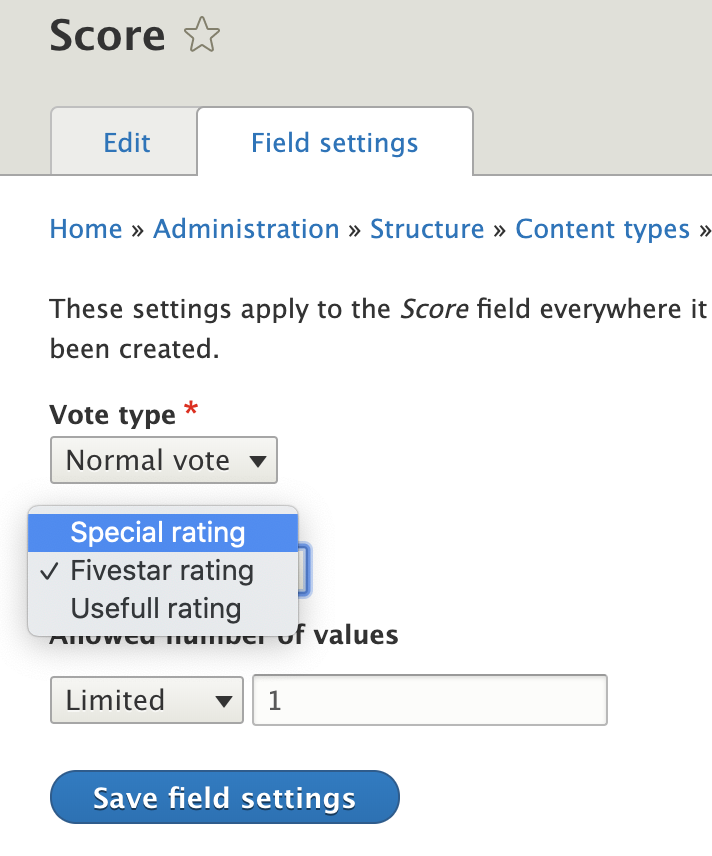
Adjusting the style of the widget can be done in the “Manage Display” section for the content type:

And here is how it looks when the voting field has been added to the Submission content type:
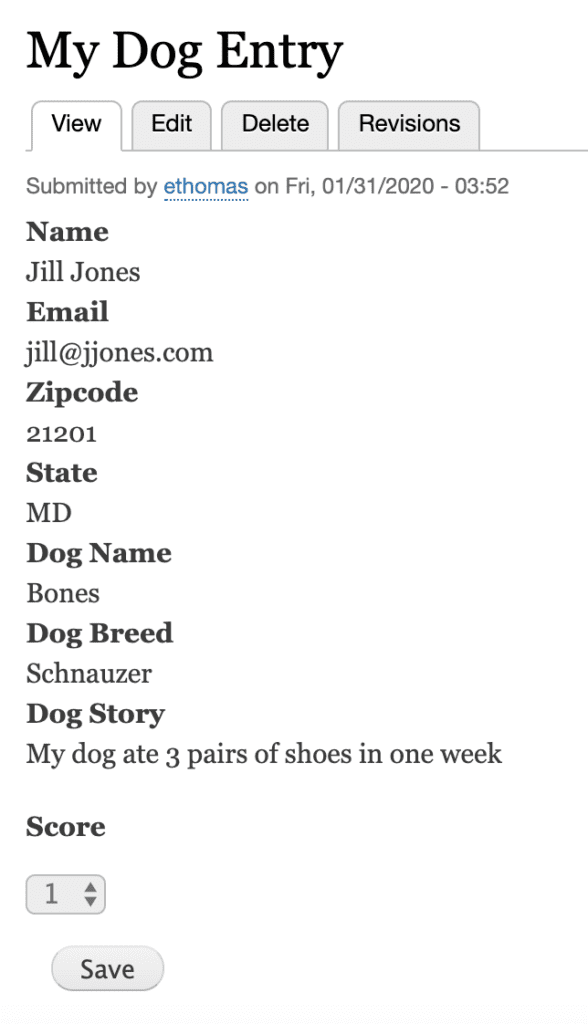
The last piece of the puzzle are the permissions. As with most custom features, your existing user roles and permissions will need to be configured to allow users to vote, change votes, clear votes, etc… — all the features that the Voting API Widgets module provides. Unless the voting will be done by authenticated users, most of the boxes should be checked for anonymous users — the general public.
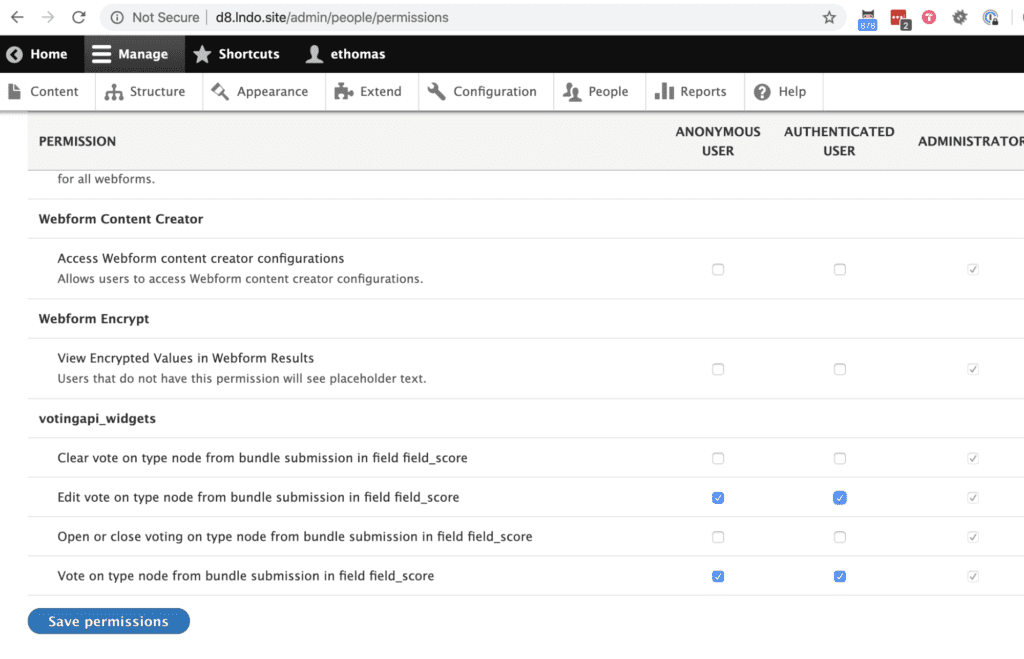
The judges can now vote on the node. A judge can vote as many times as they want, according to our client’s specs. Each vote will be saved by the Voting API. Depending on how you want to use the voting data, you can opt to display the most recent vote, the average of all votes, or even the sum of votes.
All voting data will be entered into the votingapi_vote table of your Drupal database by the Voting API module.
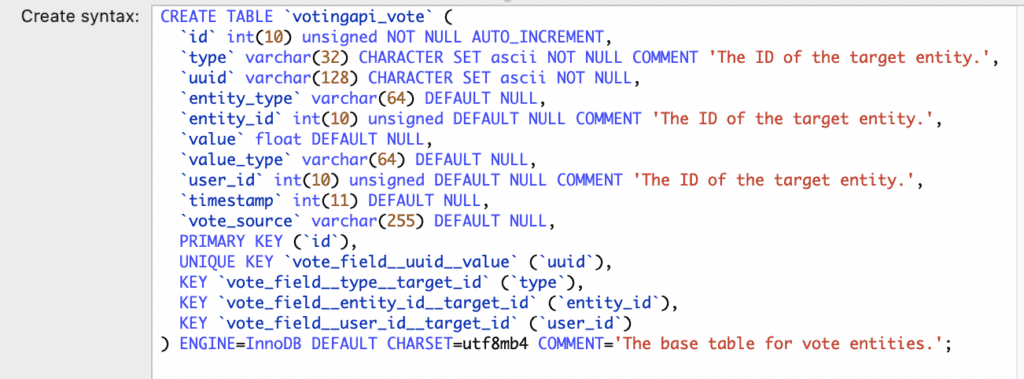
Success!
To Wrap it All Up
We hope you can appreciate the benefit of leveraging open source software within the Drupal ecosystem to power your projects and campaigns. Between the Voting API and Voting API Widgets modules alone, there were over 5,000 lines of code that our engineers did not have to write. Extending an existing codebase that has been designed with OOP principles in mind is a major strength of Drupal 8.
While not formally decoupled, we were able to separate the webform and submission theming structurally from the voting functionality so that our designers and engineers could work side-by-side to deliver this project. Credit to our team members Phil Frilling and Ben Holt for technical assists. The client rated us 10 out of 10 for satisfaction after voting was formally opened in a live environment!